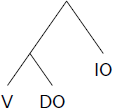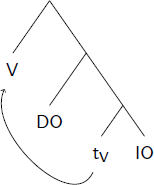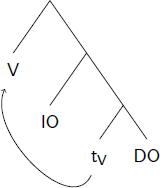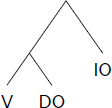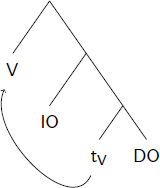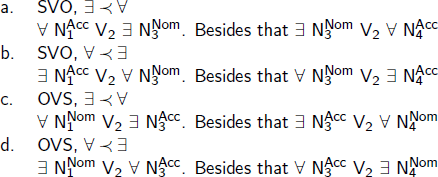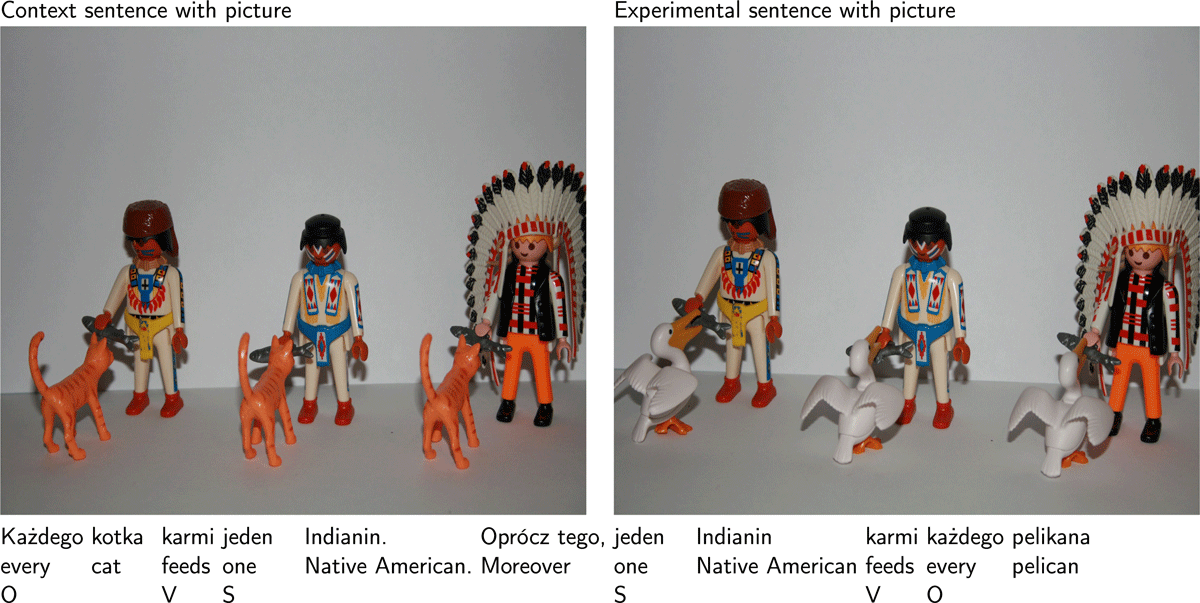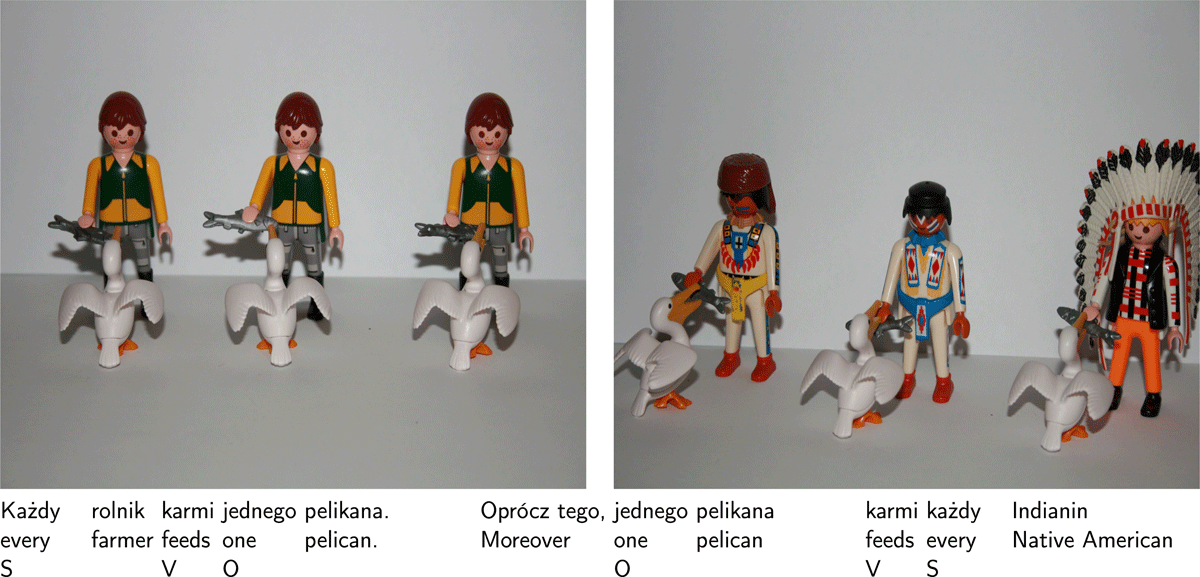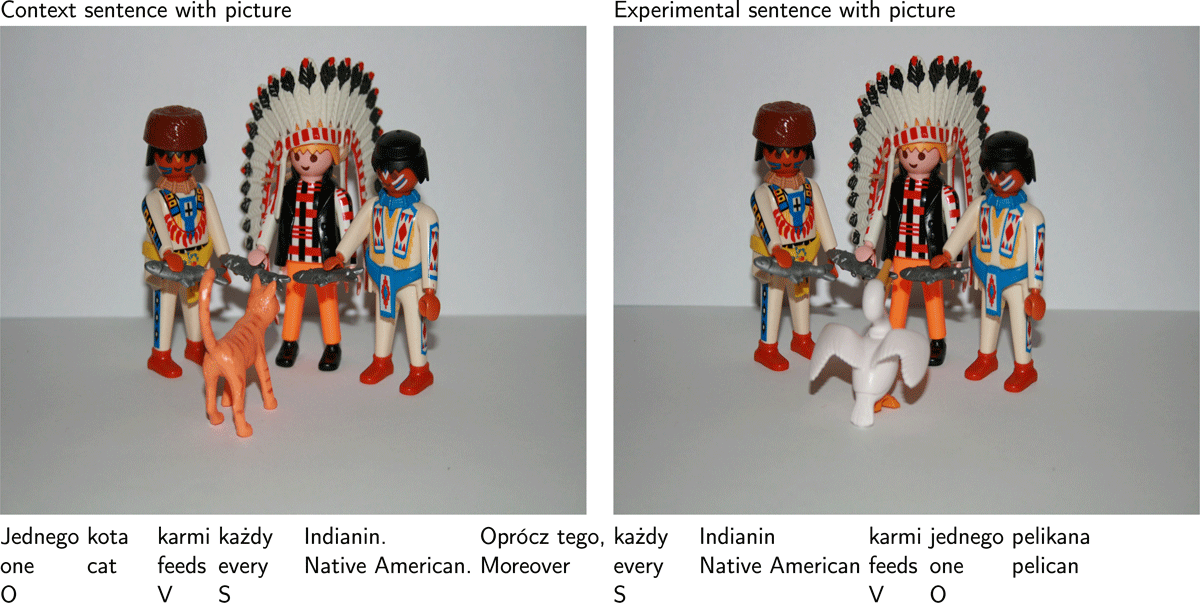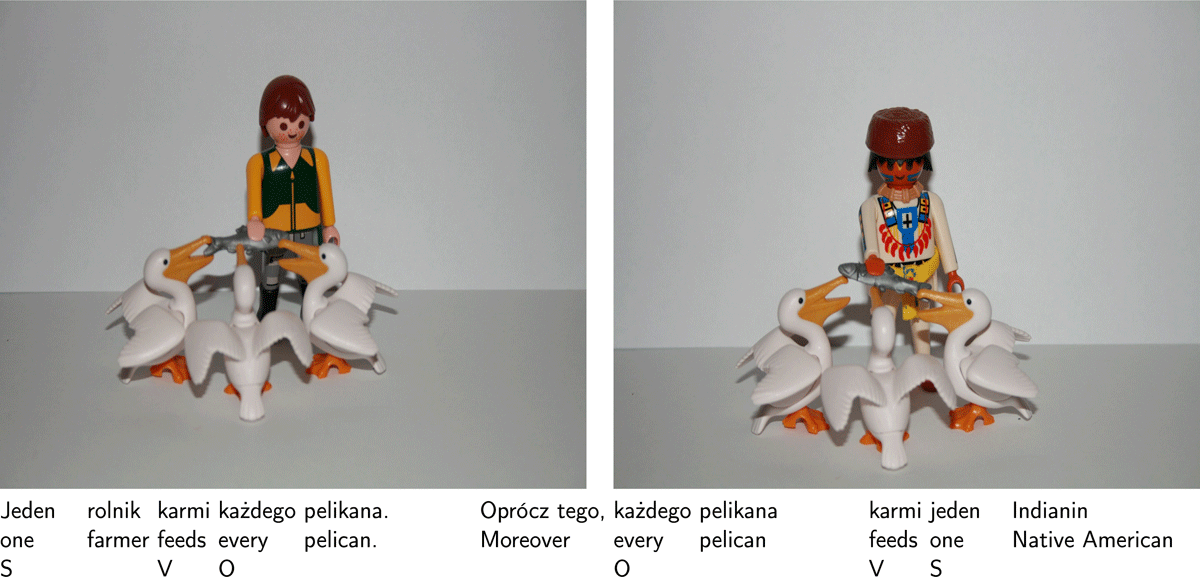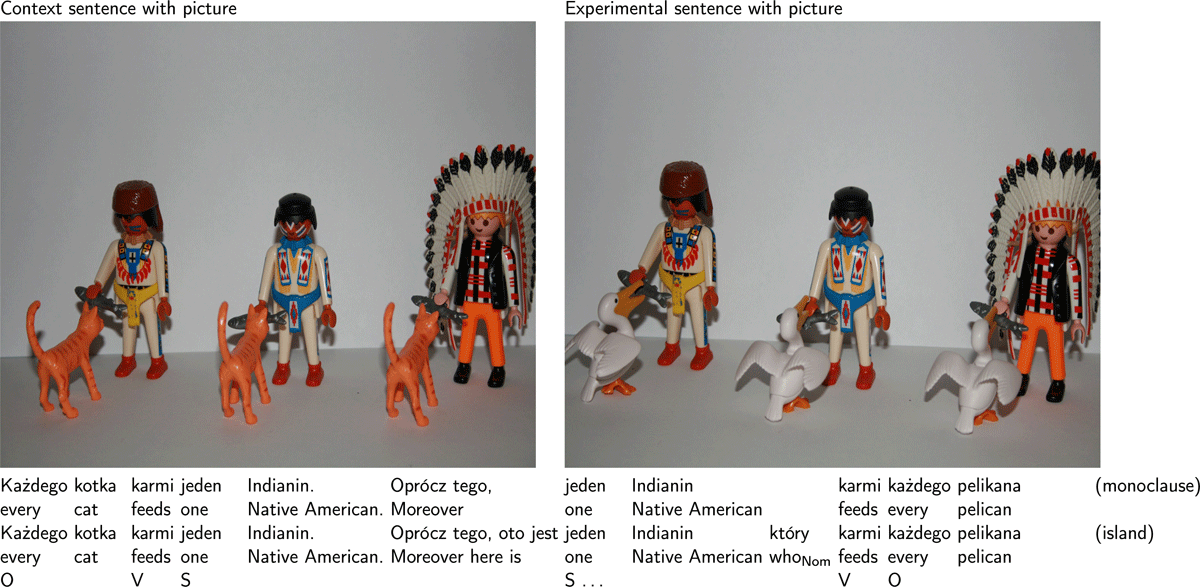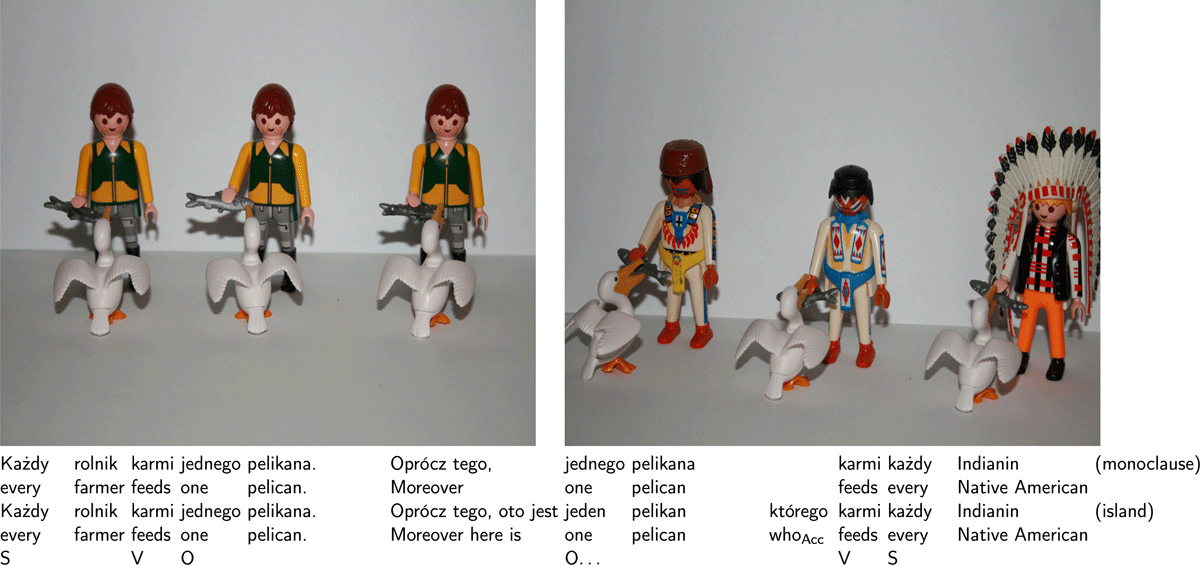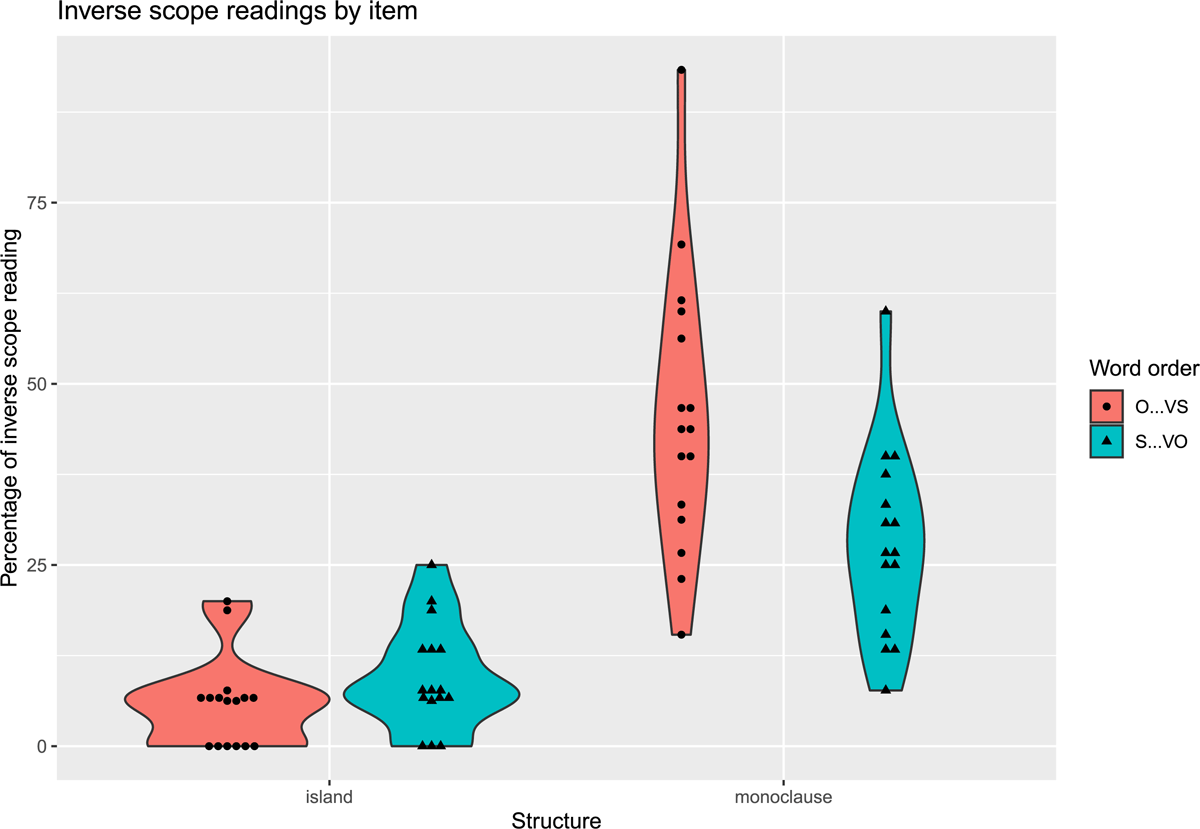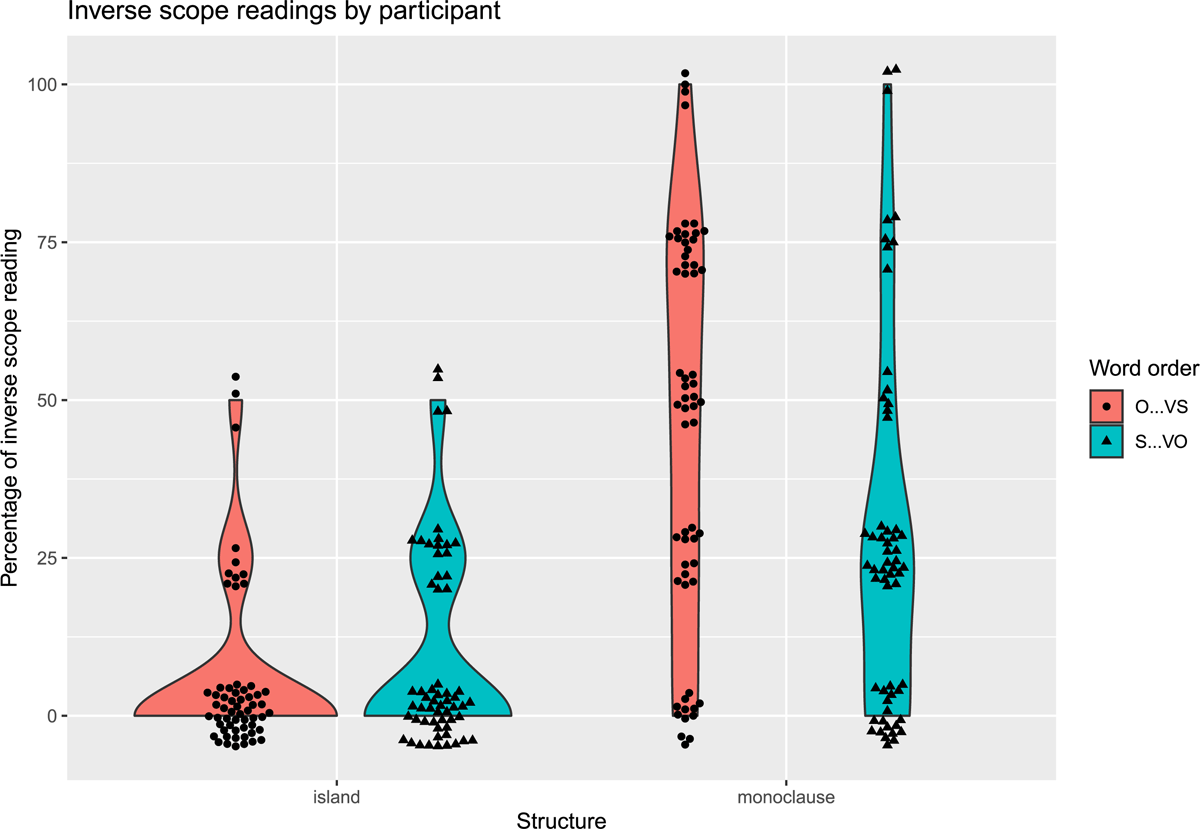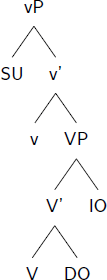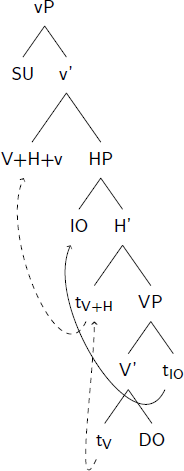1 Introduction
Sentences with two quantifiers can be scopally ambiguous. This paper is concerned with the distribution of this ambiguity in Polish. It contributes to the debate on free word order languages, in which the distribution of ambiguity is often claimed to be more restricted than in languages with more rigid word order like English. Our experimental work on Polish does not support this view.
We assume that the relative scope of quantifiers is determined by (asymmetric) c-command at LF. LF configurations can either match the surface configuration (surface scope) or mismatch it (inverse scope). If one quantifier has crossed another in the overt syntax, inverse scope can be analysed using reconstruction. If no crossing movement has occurred, inverse scope requires a scope extending mechanism such as quantifier raising (henceforth QR).
We refer to configurations in which the surface c-command relation of the quantifiers is reversed relative to their first merge position, as “crossed:”
- (1)
- Crossed configuration:
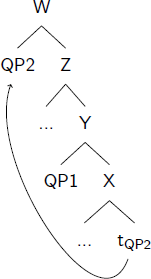
Configurations in which the underlying hierarchical relations are preserved on the surface will be called “non-crossed:”1
- (2)
- Non-crossed configuration:
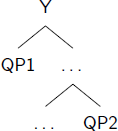
This terminology is unusual, but it will become useful when discussing different theories of the distribution of scope ambiguity; many of them rely in different ways on the distinction that our terminology highlights.
Section 2 introduces basic facts concerning the distribution of scope ambiguities in English and their standard analysis. Section 3 summarises representative theories of the distribution of scope ambiguities in free word order languages and their theoretical underpinnings. Section 4 briefly illustrates the effect of information structure on word order in Polish (given precedes new) and reviews the literature on quantifier scope ambiguities in the language. We also justify a specific analysis of ditransitive VPs in Polish using both new and well-known data. Section 5 reports the results of a truth value judgment experiment using doubly-quantified SVO and OVS sentences showing that both are ambiguous. We also sketch our general approach to quantifier raising here. Section 6 rests empirically on the results reported in Łęska 2019 and in the experiment in appendix II. Łęska 2019 shows that V-DO-IO structures are scopally ambiguous in Polish and V-IO-DO structures are unambiguous. While Łęska 2019 shows this only for structures with accusative direct objects and dative indirect objects, the experiment in appendix II replicates this and, crucially, generalises the result to structures with accusative direct objects and prepositional indirect objects. We adapt Bruening’s (2001) approach to scope freezing to the structures for ditransitive VPs in Polish emerging from section 4.3. Section 7 concludes.
The paper has three appendices. Appendix I contains the experimental materials for experiment 1. Appendix II describes reports on an experiment on scope ambiguities in ditransitive structures in Polish (experiment 2). Appendix III contains the experimental materials for experiment 2.
2 Some facts about the distribution of ambiguity in English
English is a language with relatively rigid word order. Its scope taking behavior is well-studied and often contrasted with that of free word order languages. We briefly introduce three facts about the distribution of quantifier scope ambiguity in English: SVO and S-V-DO-IO structures are ambiguous, while S-V-IO-DO structures are unambiguous. We sketch an account of these facts in terms of QR and mention three further observations that motivate the existence of QR (island sensitivity, inverse linking and antecedent contained deletion (ACD)). These facts are relevant to our comparison between Polish and English in later sections.
English doubly-quantified sentences with SVO order like (3) and (4) can be ambiguous between the surface scope interpretation and the inverse scope interpretation.
- (3)
- One Native American is feeding every cat.
- a.
- Surface Scope (∃ > ∀)
- There is a single Native American who is feeding every cat.
- b.
- Inverse Scope (∀ > ∃)
- For each cat, there is a (different) Native American who is feeding it.
- (4)
- Every Native American is feeding one cat.
- a.
- Surface scope (∀ > ∃)
- For every Native American there is a (different) cat that he is feeding.
- b.
- Inverse scope (∃ > ∀)
- There is a single cat such that every Native American is feeding it.
The crucial examples are (3-b), which clearly demonstrates the existence of the inverse scope construal, and (4-a), which clearly demonstrates the existence of the surface scope construal.
The existence of a syntactic quantifier scope ambiguity cannot be justified by either (3) or (4) alone, although both have two readings. The crucial readings are the ones with wide scope for the universal.2 Wide scope of the existential could fall out either as special case (Reinhart 2006) or because the indefinite receives a singleton restriction (Schwarzschild 2002). Generally, syntactic wide scope of a universal can be detected through the presence of a referentially dependent (distributive) reading of an indefinite but syntactic wide scope of an indefinite cannot be detected simply by observing a referentially independent reading (see Szabolcsi 1997; Winter 2001 among many others).
Since (3) and (4) together furnish clear evidence for both relative scopes, the sentence type (SVO) is ambiguous.
A second context for quantifier scope ambiguities in English are to-datives:
- (5)
- The fisherman gave one fish to every shark.
- a.
- ∀ > ∃
- For every shark there is a (different) fish that the fisherman gave to the shark.
- b.
- ∃ > ∀
- There is a single fish such that the fisherman gave it to every shark.
- (6)
- The fisherman gave every fish to one shark.
- a.
- ∀ > ∃
- For every fish there is a (different) shark that the fisherman gave the fish to.
- b.
- ∃ > ∀ There is a single shark that the fisherman gave every fish to.
Both (5) and (6) allow the universal to take scope over the existential. Since both direct and indirect object may take wide scope, to-datives are scopally ambiguous. It is not obvious whether surface scope is left-to-right or right-to-left, since there are two a priori plausible types of analysis:
- (7)
- (8)
Assuming the rightward ascending structure (7) (see Janke & Neeleman 2012 for justification) and ignoring the preposition, right-to-left scope in (5) corresponds to surface scope and left-to-right scope in (6) to inverse scope. Under the rightward descending structure in (8) on the other hand, left-to-right scope in (6) represents surface scope and right-to-left scope in (5) inverse scope.3
While we do not need to decide the issue for English, we support the geometry of structure (7) for Polish V-DO-IO structures in section 4.3. We assume that IO occupies a rightward specifier position in (7).
Although the double object construction is only minimally different from the to-dative construction, it is unambiguous (Barss 1986; Larson 1988 among others). Thus, in (9), the universal takes scope over the existential, but this is not possible in (10): the reading with multiple sharks, whose existence we noted for (6), is absent.
- (9)
- The fisherman gave every shark one fish.
- Surface scope (∀ > ∃): For every shark there is a (different) fish that the fisherman gave to the shark.
- (10)
- The fisherman gave one shark every fish.
- *Inverse scope (∀ > ∃): For every fish there is a (different) shark that the fisherman gave the fish to.
The analysis of the double object construction is less contested than that of the to-dative construction. We assume that left-to-right scope in (9) represents surface scope in a rightward descending structure with verb movement:4
- (11)
In summary, SVO is an environment for scope ambiguity, V-DO-IO is an environment for scope ambiguity, and V-IO-DO is not an environment for scope ambiguity.
Non-surface scope in the ambiguous constructions is usually analysed using the covert movement operation of QR, which attaches a quantifier to a node with propositional interpretation.5 QR is scope extending if the moving quantifier c-commands another quantifier after movement that it didn’t c-command before. We defer discussion of our own view of what blocks scope-shift in the double object structure until section 6.
The following paragraphs mention three additional observations supporting the syntactic nature of quantifier scoping: island sensitivity, inverse linking and ACD.
If QR is a movement operation, it should be subject to familiar constraints on movement (see Hackl 2013). The most well-known are island constraints. QR as movement predicts that a quantifier in an island cannot move from the island and therefore cannot take scope over a quantifier outside of the island:
- (12)
- a.
- One singer was singing, because every boy was clapping.
- b.
- Here is one Native American who is feeding every cat.
(12-a) has a surface scope interpretation: A single singer’s performance is brought about by the collective applause of the entire male audience. The inverse scope interpretation is not available, although it describes a plausible scenario: for each male member of the audience there is an eager-to-perform singer whose performance is brought about by that one audience member’s applause. Likewise, (12-b) has the surface scope interpretation with a single Native American feeding a plurality of cats, but the inverse reading is not available despite its plausibility and despite its availability in the minimally different (3). Island sensitivity supports the syntactic nature of QR (see Hackl 2013; Wurmbrand 2018; Tanaka 2020).
Example (13) illustrates the phenomenon of inverse linking.
- (13)
- One member of every committee voted to abolish it.
Here the universal quantifier takes scope over the existential (non-linear non-surface scope) and the pronoun is referentially dependent on the universal. Assuming that this referential dependency requires syntactic binding and that binding requires c-command (see Heim & Kratzer 1998), the example provides evidence for the syntactic movement of the universal quantifier.
Finally, (14) illustrates ACD.
- (14)
- I will read every book that you will.
The example is synonymous with (14).
- (15)
- I will [VP2 read every book that you will [VP1 read]].
In (14) the VP corresponding to VP1 in (15) has been elided. Under a syntactic approach to ellipsis resolution, VP1 needs a syntactic antecedent. However, overtly VP2 is not suitable, as it contains the ellipsis site. This gives rise to the infamous infinite regress problem. The regress can be avoided if the quantified object undergoes QR. Once QR has applied, the ellipsis site is no longer contained in the antecedent and ellipsis resolution can proceed straightforwardly (again see Hackl 2013).
This concludes our brief introduction to the distribution of quantifier scope ambiguities and to phenomena supporting the existence of QR in English. In section 4, we show – among other things – that Polish allows inverse linking and licenses ACD. Section 5 and appendix II demonstrate that Polish behaves just like English in further respects: SVO and S-V-DO-IO structures are ambiguous, while S-V-IO-DO structures are unambiguous and quantifier scope is island-sensitive.
3 Previous claims regarding the distribution of scope ambiguity in free word order languages
The distribution of scope ambiguity in free word order languages has been claimed to be substantially different from the situation in English. Not all free word order languages show the same patterns and within a given language the reported interpretations often differ between authors. Nevertheless, we can simplify and idealize positions somewhat. Here, the notion of crossed and non-crossed configurations will become relevant. Recall that two quantifiers are in a crossed configuration if their overt hierarchical arrangement reverses the underlying arrangement; they are in a non-crossed configuration in case the underlying hierarchy is maintained overtly. With this terminology in place, we can distinguish four broad descriptions of the distribution of inverse scope in free word order languages – where it is understood that surface scope is always available:
Inverse scope is disallowed both in crossed and non-crossed configurations (Bhattacharya 2014; Ikuta 2015).
Inverse scope is allowed only in crossed but not in non-crossed configurations (Hoji 1995).
Inverse scope is allowed only in non-crossed but not in crossed configurations (Antonyuk 2015).
Inverse scope is allowed in both types of configurations and its availability is governed by other factors (Bobaljik & Wurmbrand 2012).
We discuss these positions one by one.
Bhattacharya (2014) and Ikuta (2015) claim that scope is determined fully by surface c-command in Bangla and Bulgarian, respectively: on this view, these languages lack scope extending QR and scope reducing reconstruction.6
Hoji (1985) claims that in Japanese inverse scope is available in crossed but unavailable in non-crossed configurations: SOV (16) only allows surface scope while OSV (17) is scopally ambiguous.
- (16)
- Dareka-ga
- Someone.nom
- daremo-o
- everyone.acc
- aisiteiru.
- love
- (17)
- Dareka-o
- Someone.acc
- daremo-ga
- everyone.nom
- aisiteiru.
- love
Hoji assumes that Japanese lacks QR – hence the lack of inverse scope in non-crossed configurations like (16). However, in crossed configurations like (17) – which is derived by scrambling the object over the subject – reconstruction can give rise to inverse scope.7
For ditransitive structures Japanese IO-DO-V is reportedly unambiguous while DO-IO-V is ambiguous (Hoji 1985; Miyagawa & Tsujioka 2004; Harada & Larson 2009). A Hoji-style analysis assumes that the indirect object underlyingly c-commands the direct object, and that the ambiguous DO-IO-V order results from scrambling and represents a crossed configuration.
We now move on to Antonyuk’s theory. While Hoji associates lack of ambiguity with non-crossed configurations (no QR) and ambiguity with crossed configurations (reconstruction), Antonyuk does the opposite. She claims that in Russian, crossed configurations are unambiguous (marking scope through overt inversion) and non-crossed ones are ambiguous (allowing QR). More specifically, Antonyuk 2019: 48 #8 proposes the following condition:8
- (18)
- Scope Freezing Generalization (SFG)
- Scope freezing results when one QP raises over another to a c-commanding position within the VP as a result of a single instance of movement.
Antonyuk 2015; 2019 argues that QR is available in Russian. This allows inverse scope in SVO and in OVS structures (see Ionin & Luchkina 2018 for experimental support). However, neither reconstruction nor QR are available in VP-internal crossed configurations, where movement thus marks scope overtly.
VP internal crossed configurations can arise with ditransitives. The issue is somewhat complex, because Antonyuk distinguishes three classes of verbs and assigns them different underlying structures. We concentrate on class I here, because all verbs in experiment 2 are translation equivalents of class I verbs. Class I includes for example prinesti–’bring’, prostit’–’forgive’, and potrebovat’–’demand’ (Antonyuk 2015; p. 207–208). The first two combine with two DPs in the accusative and dative respectively while the latter combines with an accusative DP and a PP. Antonyuk assumes that underlyingly, class I verbs have the structure in (8).9 Both V-DO-IO and V-IO-DO orders are possible, but Antonyuk reports that V-DO-IO is scopally ambiguous and V-IO-DO order is not (Antonyuk 2015 p. 240 ex. 101, 2020. This view is broadly confirmed for Polish in Łęska 2019 and experiment 2. Boneh & Nash 2017 offer a different assessment of the situation in Russian, to which we briefly turn at the end of section 6):10
- (19)
- Vanja
- Vania
- prines
- brought
- kakuju-to
- some
- novost’
- news.acc
- každoj
- every
- sem’e
- familydat
- ‘Vania brought some piece of news to every family’ ∃ > ∀, ∀ > ∃
- (20)
- Vanja
- Vania
- prines
- brought
- kakoj-to
- some
- sem’e
- family.dat
- každuju
- every
- novost’
- news.acc
- ‘Vania brought some family every piece of news’ ∃ > ∀, * ∀ > ∃
On Antonyuk’s assumptions external merge of the objects of class I verbs leads to the structure and order in (8): V-DO-IO is non-crossed and allows inverse scope while V-IO-DO is crossed and thus does not allow inverse scope:
- (21)
- Structure according to Antonyuk 2019: 62, Figure 1:
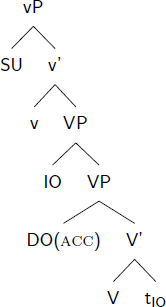
Lastly, we turn to the fourth type of theory. Bobaljik and Wurmbrand assume that inverse scope is in principle available in both crossed and non-crossed configurations in free word order languages (e.g., German). Example (22) shows the availability of inverse scope in a non-crossed configuration. Such examples motivate the availability of covert QR in German. The availability of inverse scope in crossed configurations in German is, of course, extremely well known and documented (Haider 1993; Frey 1993; Lechner 1998; Pafel 2005) and motivates the availability of scope-altering reconstruction in Bobaljik and Wurmbrand’s system (see Bobaljik & Wurmbrand 2012: 398 ex. 38a).
- A:
- Jetzt zu den Studenten. Was hat mindestens ein Student gelesen?
- ‘Let’s talk about the students. What did at least one student read?’
- B:
- Das
- that
- weiss
- know
- ich
- I
- nicht,
- not,
- aber
- but
- mindestens
- at.least
- ein
- one
- Schüler
- pupil
- hat
- has
- jeden
- every
- Roman
- novel
- gelesen.
- read
- I don’t know, but at least one pupil read every novel.
- ∃ ≺ ∀, ∃ > ∀|∀ > ∃
In their theory, there is no language-wide QR parameter and no prohibition against inverse scope in crossed configurations. This does not mean that anything goes. Firstly, QR is a restricted operation (island sensitivity, scope freezing in double object constructions). Secondly, word order can be used to signal a number of interpretive properties, such as scope and information structure in free word order languages. Word order alternations obey a violable constraint that favors a transparent mapping between LF and PF:
- (23)
Crucially, ScoT applies not only to quantifier scope relations in the most narrow sense but also to information structure (Bobaljik & Wurmbrand 2012: section 3), in which domain it requires [TOP]»[FOC]. When quantifier scope and information structure align in their impact on word order, non-surface scope is impossible. However, when they fail to align, it is possible. Consider Table 1 (Bobaljik & Wurmbrand 2012: 395), which illustrates the interaction between LF c-command (A»B or B»A), information structure requiring [TOP]»[FOC], and word order as regulated by ScoT. When quantifier scope and information structure align, scope extending QR is ruled out. When the two factors misalign, scope extending QR and thus inverse scope becomes possible; in the misalignment condition, a violation of ScoT either for scope or information structure is unavoidable.
Interactions between order, scope, and information structure according to Bobaljik & Wurmbrand 2012.
| LF | IS | PF | ScoT | ||
| Scope = IS | |||||
| * (QR) | B»A | B[TOP]»A[FOC] | A[FOC]»B[TOP] | * (LF, IS) | |
| ✔ | B»A | B[TOP]»A[FOC] | B[TOP]»A[FOC] | ✔ | |
| Scope ≠ IS | |||||
| ✔ (QR) | B»A | A[TOP]»B[FOC] | A[TOP]»B[FOC] | * (LF) | |
| ✔ | B»A | A[TOP]»B[FOC] | B[FOC]»A[TOP] | * (IS) |
In addition to allowing scope extending QR, Bobaljik & Wurmbrand assume that scope reduction is available through semantic reconstruction in crossed configurations (Bobaljik & Wurmbrand 2012: section 4). Thus, both crossed (OSV) and non-crossed (SOV) orders can give rise to inverse scope.
The theory predicts that, under the right contextual conditions, non-surface scope should be available in all cases where it is in English. We will discuss what those conditions are for Polish in the next section and control for them in the experiments.
The remainder of the current paper is dedicated to investigating the situation in Polish. We show that of the four theoretical archetypes from Table 1 Bobaljik and Wurmbrand’s position best describes the situation in Polish.
4 Background on Polish
In this section, we illustrate that Polish is a free word order language in which word order is partly determined by information structure and follows a given-before-new pattern. We then review the literature on the distribution of scope ambiguity in Polish. Finally, we argue that for Polish ditransitive verbs comparable to Antonyuk’s class I, V-DO-IO has structure (7) and V-IO-DO has structure (11). Neither order involves crossing.
4.1 Polish as a free word order language
There is general agreement that Polish allows considerable variation in the order of major clausal constituents. Thus, example (24) in principle allows all six logically possible permutations of subject, verb and object.
- (24)
- Indianin
- Native American.nom
- karmi
- feeds
- pelikana.
- pelican.acc
- a.
- Indianin
- S
- karmi
- V
- pelikana.
- O
- b.
- Pelikana
- O
- karmi
- V
- Indianin.
- S
- c.
- Indianin
- S
- pelikana
- O
- karmi.
- V
- d.
- Pelikana
- O
- Indianin
- S
- karmi.
- V
- e.
- Karmi
- V
- Indianin
- S
- pelikana.
- O
- f.
- Karmi
- V
- pelikana
- O
- Indianin.
- S
Constituent order in Polish is not random: SVO is generally considered to be the neutral word order. This order occurs in a wide variety of contexts and is compatible with all-new utterances, utterances with VP focus and utterances with object focus. In the latter two, SVO instantiates the given-before-new pattern, as shown in (25).12
- (25)
- Indianin
- Native American.nom
- karmi
- feeds
- psa
- dog.acc
- i
- and
- Indianin
- Native American.nom
- karmi
- feeds
- pelikana.
- pelican.acc
- A Native American is feeding a dog and {a|the} native American is feeding a pelican.13
With the first half of example (25) as the context, SVO results in given-before-new and is perceived as the most natural order. In this context, reversing subject and object in the second conjunct, creating a new-before-given sequence, is felt to be unnatural without marked intonation.
While we have just seen that OVS is unnatural if the object is new and the subject is old, the order becomes unremarkable when the object is old and the subject is new:
- (26)
- Rybak
- fisherman.nom
- karmi
- feeds
- pelikana
- pelican.acc
- i
- and
- pelikana
- pelican.acc
- karmi
- feeds
- Indianin.
- Native American.nom
- A fisherman is feeding a pelican and a Native American is also feeding {a|the} pelican.
These examples illustrate the substantial freedom of constituent order and the role of information structure in Polish. We have seen that given material precedes new material. To be sure, this statement is a gross oversimplification; many other factors play a role in determining word order in Polish. We have already mentioned intonation, but the presence of presupposition-inducing particles (even, only, also), heaviness, animacy, specificity, etc. have all been suggested to play a part in determining word order. The experiments in section 5 and appendix II are designed to avoid these complications by motivating the word order in line with the given-new preference and keeping all other factors constant.
4.2 Previous claims on the distribution of scope ambiguity in Polish
Section 3 noted that the distribution of scope ambiguity in free word order languages is often disputed. Polish is a case in point, as we will now document.
Karnowski 2001 and Łęska 2019 are the only works we are aware of which are exclusively dedicated to quantifier scope in Polish. Karnowski deals with monotransitives while Łęska only discusses ditransitives. Karnowski claims that SVO orders like (27) are unambiguous while OVS orders like (28) are ambiguous. Karnowski accounts for the distribution of ambiguity invoking a number of factors. The difference between SVO and OVS is the result of the interaction of two such factors: linear precedence (correlated with surface c-command) and grammatical function. Linear precedence simply demands that a quantifier to the left of another quantifier takes wide scope and explains the availability of surface scope in both orders. Grammatical function allows subjects to take scope over objects independently of the order. This allows for inverse scope in OVS but not in SVO sentences. The result is similar to a Hoji-style analysis that allows surface scope and reconstruction but disallows QR.
- (27)
- (Przynajmniej)
- At least
- jeden
- one
- z
- of
- germanistów
- GermanistsS
- przeczytał
- read
- każdą
- every
- powieść
- novel
- Bölla.
- BöllO
- (At least) one Germanist read every novel by Böll. Karnowski (2001: p. 433, ex. 25)
- (28)
- (Przynajmniej)
- At least
- jedną
- one
- z
- of
- powieści
- novels
- Bölla
- BöllO
- przeczytał
- read
- każdy
- every
- germanista.
- GermanistS
- Every Germanist read (at least) one novel by Böll. Karnowski (2001: p. 433, ex. 23)
Szczegielniak 2005 also discusses SVO orders. He gives the following example and claims (contra Karnowski) that it is ambiguous.
- (29)
- Jakiś
- some.nom
- chłopiec
- boy.nom
- pocałował
- kissed
- każdą
- every.acc
- dziewczynkę.
- girl.acc
- Some boy kissed every girl. Szczegielniak (2005: 25 ex. 30a)
Szczegielniak attributes the ambiguity he perceives to the availability of QR in Polish.
Finally, Witkoś (2000) discusses two types of examples that are relevant for our discussion.
- (30)
- Przynajmniej
- at least
- jeden
- one.nom
- krzykacz
- heckler.nom
- jest
- is
- obecny
- present
- na
- at
- każdym
- every.loc
- zebraniu.
- meeting.loc
- One heckler like that is present at every meeting. Witkoś (2000: 175 ex. 45a)
- (31)
- Przynajmniej
- at least
- jeden
- one.nom
- krzykacz
- heckler.nom
- wydaje
- seems
- się
- refl.
- być
- be
- obecny
- present
- na
- at
- każdym
- every.loc
- zebraniu.
- meeting.loc
- One heckler like that seems to be present at every meeting. Witkoś (2000: 175 ex. 46a)
He claims that in both examples inverse scope is possible (in addition to surface scope) and suggests that in the first example inverse scope is derived by raising the universal quantifier covertly across the subject.14 The second of Witkoś’s examples is intended to motivate the existence of reconstruction. On the assumption that QR is clause-bounded, the universal cannot raise covertly out of the infinitival complement of seem in (31). Thus, inverse scope requires reconstruction of the existential.
The three papers just cited disagree partially on the relevant facts. They also represent different theoretical archetypes regarding scope in free word order languages.
Possibly a different archetype is instantiated in Citko (2011), a work whose main focus is the syntax of wh-questions. Citko claims that V-IO-DO unambiguously shows linear scope; what her assessment of the scope of V-DO-IO is is not entirely clear, but in light of the following remark it seems reasonable to attribute to her the claim that V-DO-IO, too, only has linear scope: “[f]rozen scope is a more general fact about Polish, extending beyond double object constructions. This is not surprising; in free word order languages (such as Polish) scope generally reflects the linear ordering of the two quantifiers” (Citko 2011: p. 234 fn. 38).
- (32)
- Nauczyciel
- teacher.nom
- zadał
- assigned
- jednemu
- one.dat
- studentowi
- student.dat
- każde
- every.acc
- zadanie.
- task.acc
- A teacher assigned one student every problem. Citko(2011: 142 ex. 108b)
- (33)
- Nauczyciel
- teacher.nom
- zadał
- assigned
- jedno
- one.acc
- zadanie
- task.acc
- każdemu
- every.dat
- studentowi.
- student.dat
- A teacher assigned one task to every student. Citko (2011: 234 fn 37 ex. (i))
The remark just quoted suggests that Citko may entertain ideas similar to Bhattacharya (2014) and Ikuta (2015).
The scope facts for ditransitives turn out to be no less contested than those for monotransitive structures. Like Citko, Wiland 2009 and Łęska 2019 discuss scope relations in ditransitive structures. Wiland gives the following examples and suggests that V-IO-DO is scopally rigid, (34), while V-DO-IO is scopally ambiguous, (35). Łęska 2019 interprets her experimental results the same way.
- (34)
- Piotr
- Piotr
- (szybko)
- quickly
- dał
- gave
- jakiemuś
- some.dat
- chłopcu
- boy.dat
- każdą
- every.acc
- naszą
- our.acc
- monetę.
- coin.acc
- Peter quickly gave some boy every coin of ours. Wiland (2009: 99 ex. 191a)
- (35)
- Piotr
- Piotr
- (szybko)
- quickly
- dał
- gave
- każdą
- every.acc
- naszą
- our.acc
- monetę
- coin.acc
- jakiemuś
- some.dat
- chłopcu.
- boy.dat
- Peter quickly gave every coin of ours to some boy. Wiland (2009: 99 ex. 192)
While these examples involve a different verb from Citko’s, we do not think that this drives the difference in reported interpretations. Both authors use animate indirect objects and inanimate direct object and both verbs come from Antonyuk’s class I.
Wiland assumes that, in the underlying hierarchical structure for both orders, the indirect object c-commands the direct object in a rightward descending structure like (11). The hierarchical relation is overtly preserved in example (34), while in (35), the direct object moves leftward across the indirect object. Wiland explains the scope rigidity of (34) and the ambiguity of (35) by assuming that QR is unavailable but reconstruction is available in Polish. Łęska 2019 follows Wiland’s analysis. This approach echoes Hoji’s theory of scope in Japanese and Karnowski’s work on Polish. Spinning out the parallelism with these works further, it seems reasonable to attribute to Wiland and Łęska the prediction that OVS orders should be ambiguous and SVO orders—unambiguous. Neither of them discuss this, but we have seen that this is just the position taken by Karnowski.
It should be obvious from the brief overview that a systematic and careful investigation of the distribution of scope ambiguities in Polish will help to resolve the implicit dispute between these authors and to fill the descriptive gap. The only two facts that the literature agrees on is that linear scope is always possible and that V-IO-DO lacks non-linear scope.
While the literature paints a confusing picture, independent considerations suggest that Polish has QR. Example (36) (from Grabska 2017: 14 ex. 13) illustrates the availability of inverse linking in Polish. Example (37) (from Szczegielniak 2005: 2 ex. 3) illustrates the availability of ACD in the language.15 Grabska 2017 points out that such data suggest that Polish allows QR, since ACD and inverse linking are usually assumed to require it.
- (36)
- Jakiś
- some
- mieszkaniec
- inhabitant.nom
- każdego
- every
- miasta
- city.gen
- nienawidzi
- despises
- go.
- it.gen
- An inhabitant of every cityi despises iti
- (37)
- Ja
- I.nom
- będę
- will
- czytać
- read
- każdą
- every
- książkę
- book.acc
- {co
- that
- | którą}
- which
- ty
- you
- będziesz
- will
- (czytać).
- (read)
- I will read every book that you will (read).
As we will see, the experimental results strongly support the availability of QR in Polish. It will turn out that Witkoś and Szczegielniak are correct in their description of scope in monotransitive structures and Wiland and Łęska in theirs concerning ditransitives.
4.3 The structure of ditransitive VPs in Polish
Our goals in this paper are not exclusively descriptive. We are also trying to distinguish different theoretical approaches to the syntax of scope. In order to know what predictions various theories make, it is necessary to establish whether or not a given surface order represents an overtly crossed configuration. This is because crossed configurations afford the possibility of reconstruction under theories like Hoji’s while under Antonyuk’s theory VP-internal crossed configurations are unambiguous. Mutatis mutandis for non-crossed configurations. The aim of this section is therefore to propose an answer to the question of what the structure of relevant ditransitive VPs in Polish is.16 Holding conclusions about the structure firm, will then allow us to adjudicate between different theories of scope taking.
In this subsection, we defend the view that for the verbs used in experiment 2 neither V-IO-DO nor V-DO-IO involves crossing. We implement this assumption by essentially following Janke & Neeleman’s 2012 analysis of ditransitive structures in English. Under their analysis, the direct object has to be adjacent to the verb at some stage of derivation in order to facilitate accusative case licensing on the direct object. Adjacency between the verb and direct object is transparently given on the surface in V-DO-IO orders, which have a relatively simple rightward ascending structure, repeated from (7):
- (38)
Note that we use IO as a cover for dative DPs and for a range of PPs; (38) covers [[V DPacc] DPdat] and [V DPacc] PP]. Similarly for (39). V-IO-DO orders, on the other hand, cannot be analysed with a rightward ascending structure, because the direct object would not be adjacent to the verb at any point. Instead, V-IO-DO involves a rightward descending structure with verb movement, (39) repeated from (11). Case on the direct object is licensed from the verb’s underlying position (see also Neeleman & Weerman 1999; Haider 2005; 2006 for related ideas). To state our theory of scope freezing, we elaborate this structure further in section 6, where (11) is embellished with an additional functional projection and IO movement without disturbing the overall geometry.
- (39)
In the remainder of this subsection, we present four arguments that favor the coarse geometry shown above. The arguments are based on predicate clefts, focus projection, the syntax of idioms, and the scope of numerically quantified adverbs respectively.17
(38) and (39) jointly entail that independently of the order of the two objects there is a V-DO constituent excluding the IO (underlyingly and overtly (38) and underlyingly only in (39)). On the other hand there is never a V-IO constituent to the exclusion of DO either underlyingly or on the surface. Proposal (8) by contrast produces no V-DO constituent but does have a V-IO constituent (at least underlyingly). The diagnostics below give clear evidence for a V-DO constituent and no evidence for a V-IO constituent. Thus we adopt (38) and (39) for DO-IO and IO-DO, respectively, and reject (8) and (21), respectively.
Our first argument for the correctness of (38) and (39) for Polish comes from predicate clefts. Like many other languages, Polish possesses a predicate cleft construction that allows complete or partial VPs to be fronted. The fronted verb is then resumed in the main clause (Bondaruk 2012). Typical intransitive and transitive examples look as follows:
- (40)
- Spać,
- sleep.inf
- to
- TO
- Janek
- John
- spał,
- slept
- ale
- but
- nie
- not
- odpoczął.
- rested
- Though John did sleep, he didn’t rest.
- (41)
- Czytać
- read.inf
- książki,
- books
- to
- TO
- Janek
- John
- czytał,
- read
- ale
- but
- żadnej
- none
- nie
- not
- napisał.
- wrote
- Though John did read books, he hasn’t written any.
- (42)
- Czytać,
- read.inf
- to
- TO
- Janek
- John
- czytał
- read
- książki,
- books
- ale
- but
- żadnej
- none
- nie
- not
- napisał.
- wrote
- Though John did read books, he hasn’t written any.
The examples above illustrate that a VP or a partial VP can be fronted and resumed.
What is interesting for our purposes is the behaviour of ditransitive verbs in predicate clefts.
To the best of our knowledge, these facts have not previously been discussed. We use the verb dawać–’give’ as a representative example here. The following six examples illustrate the pattern. The first four examples establish the baseline. They show that dawać–’give’ can be fronted, both with V-IO-DO and V-DO-IO order and that the verb alone can be fronted, again both with V-IO-DO and V-DO-IO order.
- (43)
- Dawać
- give.inf
- ryby
- fish.acc
- rekinom,
- sharks.dat
- to
- TO
- rybak
- fisherman.nom
- dawał,
- gave
- ale
- but
- sam
- himself
- nic
- nothing
- nie
- not
- zjadł.
- ate
- Though the fisherman gave fish to the sharks, he himself didn’t eat.
- (44)
- Dawać,
- give.inf
- to
- TO
- rybak
- fisherman.nom
- dawał
- gave
- ryby
- fish.acc
- rekinom,
- sharks.dat
- ale
- but
- sam
- himself
- nic
- nothing
- nie
- not
- zjadł.
- ate
- (45)
- Dawać
- give.inf
- rekinom
- sharks.dat
- ryby,
- fish.acc
- to
- TO
- rybak
- fisherman.nom
- dawał,
- gave
- ale
- but
- sam
- himself
- nic
- nothing
- nie
- not
- zjadł.
- ate
- (46)
- Dawać,
- give.inf
- to
- TO
- rybak
- rybak.nom
- dawał
- gave
- rekinom
- sharks.dat
- ryby,
- fish.acc
- ale
- but
- sam
- himself
- nic
- nothing
- nie
- not
- zjadł.
- ate
These data fall out directly from our account, but they are also compatible with an alternative approach based on (8) so long as the direct object can scramble within the domain of the clefted predicate.
The next two examples are crucial. They show that there is an asymmetry when the verb is fronted together with only one of the objects: only the direct object can be fronted with the verb. (An anonymous reviewer informs us that they lack the asymmetry shown here and that for them both of the examples below are at best marginal. We discuss these particular judgments in footnote 26.)
- (47)
- Dawać
- give.inf
- ryby,
- fish.acc
- to
- TO
- rybak
- fisherman.nom
- dawał
- gave
- rekinom,
- sharks.dat
- ale…
- but
- (48)
- *Dawać
- give.inf
- rekinom,
- sharks.dat
- to
- TO
- rybak
- fisherman.nom
- dawał
- gave
- ryby,
- fish.acc
- ale…
- but
As laid out above, this state of affairs is expected under our approach, as both (38) and (39) make a V-DO constituent available – both do underlyingly, (38) does both underlyingly and on the surface. Structure (8) would predict an asymmetry in the opposite direction (if clefting can take place under reconstruction of the verb) or no asymmetry (if scrambling feeds clefting). The actual pattern cannot be captured either way.
Predicate clefting thus provides an argument in favor of our proposal. All verbs used in experiment 2 (appendix II) show the behavior exemplified here: the direct object can be clefted with the verb to the exclusion of the indirect object (realized as a dative DP or a PP) but not vice versa.
The second argument in favor of (38) and (39) as the correct structure comes from focus projection. The discussion in section 4.1 mentioned the fact that focus can project when stress falls on the object in SVO order. This is in line with the well-established generalisation that projecting focus requires stress on the most deeply-embedded argument (Halle & Vergnaud 1987; Cinque 1993; Zubizarreta 1998; Zubizarreta & Vergnaud 2006). In ditransitive structures projecting focus is possible only in the IO-DO order and only when the direct object is stressed.18
- (49)
- What happened?
- a.
- Rybak
- fisherman.nom
- dawał
- gave
- rekinom
- sharks.dat
- ryby.
- fish.acc
- b.
- #Rybak
- fisherman.nom
- dawał
- gave
- ryby
- fish.acc
- rekinom.
- sharks.dat
- c.
- #Rybak
- fisherman.nom
- dawał
- gave
- rekinom
- sharks.dat
- ryby.
- fish.acc
- d.
- #Rybak
- fisherman.nom
- dawał
- gave
- ryby
- fish.acc
- rekinom.
- sharks.dat
The examples are to be understood as answers to the context question and forcing focus projection to the clausal level. Stress is indicated by small caps. The observation that (49-a) does, but (49-b) does not allow focus projection follows directly from the structural assumption we have made because DO is the most deeply embedded argument in (39). The alternative analysis (8) predicts exactly the opposite pattern: (49-a) is a scrambled order and should lead to narrow focus and (49-b) is the canonical order with the IO the most deeply embedded argument.
The fact that (49-c) disallows focus projection also follows directly from our analysis. However, the observation that (49-d) with stress on the penultimate argument fails to allow focus projection does not immediately follow from what we have said so far, since the direct object in (49-d) is still the most deeply-embedded argument in the structure in (38). We propose that focus can only project from an argument that is both most deeply-embedded and final (see Kučerova 2007: 24–25 for the corresponding observation about Czech).19
Our approach to ditransitive VPs allows a principled account of the focus projection facts. It relies on the well-established generalization that focus projects from the most deeply embedded argument and invokes the ancillary assumption that projecting stress must be rightmost. The competing theory offers no principled approach to focus projection, as far as we can see. Again, all verbs used in experiment 2 behave like dawać–’give’ when it comes to focus projection.20
The third argument in favor of (38) and (39) comes from Witkoś & Dziemianko 2006 and is based on idioms. Witkoś & Dziemianko (2006) argue that in Polish idioms made up of a ditransitive verb and only one of its arguments always involve the direct object and never the indirect object as part of the idiom. On the assumption that underlying constituents are more likely to be subject to idiomatic interpretation than underlying non-constituents, Witkoś & Dziemianko (2006) conclude that direct objects are structurally lower than indirect objects. This is exactly what (38) and (39) claim. Examples of relevant idioms are:
- (50)
- dać
- give
- komuś
- someone.dat
- lanie
- downpour.acc
- beat someone
- (51)
- suszyć
- dry
- komuś
- someone.dat
- głowę
- head.acc
- reprimand someone
The alternative view based on (8) has no account of the direction of the asymmetry.21
The final argument in favor of (38) and (39) comes from the scope of numerically quantified adverbs. According to (39), IO is higher than DO in the V-IO-DO order. Thus, when the numeral adverbial dwa razy–’twice’ is placed between the objects in this order, dwa razy c-commands DO but not IO. It should take scope rightward over DO but not leftward over IO. This expectation is borne out:
- (52)
- a.
- Marysia
- Mary.nom
- dała
- gave
- temu
- this
- kapitanowi
- captain.dat
- dwa
- two
- razy
- times
- jedną
- one
- rybę.
- fish.acc
- twice > ∃ fish ⟹ 2 fish
- b.
- Marysia
- Mary.nom
- dała
- gave
- jednemu
- one
- kapitanowi
- captain.dat
- dwa
- two
- razy
- times
- tę
- this
- rybę.
- fish.acc
- ∃ captain > twice ⟹ 1 captain
According to (38), in the V-DO-IO order IO is again higher than DO. Thus, when dwa razy is placed between the two objects, it should again c-command DO and take scope leftward over DO but not rightward over IO. Again this expectation is essentially borne out:
- (53)
- a.
- Marysia
- Mary.nom
- dała
- gave
- jedną
- one
- rybę
- fish.acc
- dwa
- two
- razy
- times
- temu
- this
- kapitanowi.
- captain.dat
- twice > ∃ fish ⟹ 2 fish
- b.
- Marysia
- Mary.nom
- dała
- gave
- tę
- this
- rybę
- fish.acc
- dwa
- two
- razy
- times
- jednemu
- one
- kapitanowi.
- captain.dat
- ∃ captain > twice ⟹ 1 captain
We should note that right-to-left scope (2 captains) in (53-b) is not categorically excluded but strongly dispreferred. We take the dominant reading to be the crucial one here and return to the derivation of the dispreferred reading in footnote 26.
The four arguments above suggest strongly that the direct object is lower than the indirect object in both orders, that is, that structures (38) and (39) provide an adequate analysis of the data.22
In this subsection, we have discussed the hierarchical structure of relevant ditransitive verb phrases in Polish to lay the ground for our theoretical interpretation of the results of experiment 2. In order to determine what predictions various theories make about scope ambiguities, it was important to determine independently whether V-IO-DO or V-DO-IO involve crossed configurations. We have argued that neither of them do. We provided four arguments for the assumption that the direct object is structurally below the indirect object in both orders and that the relevant geometry must be as depicted in (38) and (39) - with various details to be filled in. Our arguments had to do with predicate-clefting, focus projection, idioms, and the scope of adverbials.
5 The availability of scope ambiguity in SVO and OVS sentences
In this section we explore the contradictory and confusing claims from the literature about the availability of scope ambiguity in SVO and OVS sentences formally.
An exploratory study was designed probing the availability of non-linear scope in SVO and OVS sentences. (The availability of linear scope in these structures is not in question.) 16 lexicalizations crossing the factors word order (with the levels SVO and OVS) and quantifier order (with the levels ∃ ≺ ∀ and ∀ ≺ ∃) were developed. They were presented to participants auditorily together with an image verifying a construal where the linearly second quantifier is not in the scope of the linearly first quantifier, that is, the non-linear scope construal for the ∃ ≺ ∀ conditions and the wide scope/referential indefinite interpretation for the ∀ ≺ ∃ conditions. The experimental items were preceded by a context sentence also accompanied by an image (more on which below). The task was a truth value judgment task.
The inclusion of a context sentence was motivated by three main considerations. First, because of the given-before-new preference of Polish we reasoned that the non-canonical word order in the OVS conditions combined with the neutral intonation in the recording required a context which made the object given and the subject new. The context sentences for the OVS sentences were designed to do this, those for the SVO sentences – to do the opposite. Secondly, under a Bobaljik & Wurmbrand style of analysis inverse scope violates scope transparency. Inverse scope should therefore only be available if the scopally nontransparent word order can be independently motivated. Again, the given-before-new preference served this purpose. Third, the context sentence was always paired with an image verifying the type of reading the experimental sentence would ask about: a universal distributing over an indefinite in the context sentences for the ∃ ≺ ∀ sentences and a referentially independent indefinite in the ∀ ≺ ∃ conditions. Unlike in the experimental sentence, these readings were shown and primed in the context sentence through structures where their availability is not in question, namely, where these readings correspond to the surface scope. We hoped that this priming would bolster the availability of the non-surface readings in the experimental sentence. Context sentence and experimental sentence were connected using the words oprócz tego–’besides that’.
Abstractly, full items looked as in (54), where the grammatical function could unambiguously be established via case morphology. Subscripts indicate lexical identity (the ∀ ≺ ∃ conditions are grammatical controls, there are no ungrammatical controls):
- (54)
Items with accompanying pictures in the ∃ ≺ ∀ conditions can be illustrated by the following:
- (55)
- (56)
Items with accompanying pictures in the ∀ ≺ ∃ condition are illustrated below:
- (57)
- (58)
The 64 sentences were distributed to 4 lists of 16 items without lexical repetition (4 sentences per condition), randomly ordered, and interspersed with a further 16 fillers. Participants were told that they would hear pairs of sentences accompanied by pictures. The first sentence would always be a true description of the image and the participants’ task was to determine whether the second sentence was a truthful description of the second picture. They were shown the context image and heard a recording of the context sentence followed by the second image and accompanied by a recording of the test sentence.
Our expectations were the following: We were expecting very high acceptance of the ∀ ≺ ∃ conditions. This expectation was grounded firstly in the theoretical idea that referentially independent indefinites do not require a syntactic scoping mechanism like QR and should therefore be available in Polish independently of its freedom of word order. This expectation was also based on experimental findings such as Scontras & Polinsky & Tsai 2017, who show that referentially independent readings of indefinites in ∀ ≺ ∃ order are available even in languages like Mandarin which show no evidence of inverse scope for universal quantifiers. We have laid out the theoretically grounded expectations of grammaticality arising from different theories for ∃ ≺ ∀ conditions above. We anticipated that clearly ungrammatical readings would be rejected at about the same rate at which the clearly acceptable ∀ ≺ ∃ items were accepted (see the symmetric acceptance rates for surface and inverse scope of every in the Mandarin experiment in Scontras & Polinsky & Tsai 2017: 16). Based on the findings in Anderson (2004: experiment 2), we expected acceptance rates of grammatical instances of inverse scope in ∃ ≺ ∀ to fall in the range given by Anderson’s inverse biased (53%) to unambiguous inverse (91%).
18 subjects participated in the experiment. All were native speakers of Polish residing in Poland. Data was treated in line with the Data Protection Act of 1998 and participants gave informed consent.
Overall means and standard deviations are reported in the table below, where the mean is the rate of true responses:23
- (59)
- word order
- SVO
- SVO
- OVS
- OVS
- quantifier order
- ∃ ≺ ∀
- ∀ ≺ ∃
- ∃ ≺ ∀
- ∀ ≺ ∃
- mean
- 0.603
- 0.912
- 0.750
- 0.926
- sd
- 0.493
- 0.286
- 0.436
- 0.263
We interpret these results as a preliminary indication that both SVO and OVS sentences allow inverse scope and are, therefore, scopally ambiguous. This is in keeping with works like Ionin & Luchkina 2018 in which acceptance rates of 30% and 37% in a similar task (but without context sentences) are interpreted as evidence for the grammatical availability of inverse scope (see Ionin & Luchkina 2018: 767–8).
5.1 Experiment 1: Monoclause versus island
With this preliminary exploration complete, we set out to show with a formal experiment that both SVO and OVS sentences are scopally ambiguous by contrasting these conditions with minimally contrasting but clearly unambiguous controls.24 As before, surface scope conditions were not included in the experiment, because their acceptability is not in doubt.
To this end we designed an experiment fully crossing the two factors word order (with the levels S… VO and O… VS) and structure (with the levels monoclause and island). All experimental sentences had the order ∃ ≺ ∀. We dropped the ∀ ≺ ∃ conditions from the exploratory study because they are uninformative for this study. The island conditions are clearly unambiguous and allow only the surface construal. Thus if the minimally paired monoclausal examples are statistically significantly more prone to the inverse scope interpretation, this can be taken as evidence against the null hypothesis that they, too, are unambiguous.
5.2 Materials
The 16 lexicalization of OVS and SVO for the ∃ ≺ ∀ conditions (and accompanying pictures) were used from the exploratory study. In addition to these 32 sentences, minimally paired unambiguous sentences containing scope islands and blocking reconstruction were developed. These items had a cleft-like structure that can be roughly translated as here is one N that Vs every N (S… VO) and Here is one N that every N Vs (O… VS).
Abstractly the full items (including the context sentences, which were identical to those used in the exploratory study) looked as follows. As before, Subscripts indicate lexical identity.
- (60)
The grammatical function of each noun phrase could unambiguously be established via case morphology on the noun phrase or on the relative pronoun.
The images were identical for the monoclausal and the island conditions:
- (61)
- (62)
The 64 experimental sentences were distributed to four lists to avoid lexical repetition so that each participant would see and hear four items per condition.
In addition to the experimental items, 32 fillers were developed. Half of the fillers were paired with a picture matching the second sentence and half with a picture mismatching it. In addition, three practice items following the same general pattern were created.
All sentences were recorded by a female native speaker of Polish (the first author of this paper) and spoken with neutral intonation. The full list of sentences from the experiment can be found in appendix I.
5.3 Method
All stimuli were loaded onto the experimental internet platform Gorilla, where the experiment was programmed. The items were randomly ordered and pseudorandomly interspersed with fillers. Participants needed to be on a computer or tablet (but not a mobile phone) to participate. To progress to the main experiment, participants had to declare that they are at least 18 years old, were informed of their right to withdraw at any point, and had to give informed consent to the processing of their data under GDPR rules. They needed to fill in a sociometric questionnaire, read the instructions, and had to correctly respond to two of three practice items. The practice phase was repeated until participants had correctly responded to two of the three items but at most three times. Any participants who did not pass the practice phase would have been excluded from the analysis. Following the practice, participants reached the main experiment, which was followed by a debriefing screen asking participants to reflect in Polish on the experiment. The point of this was to identify any conscious strategies participants might be using and to verify that they were speakers of Polish.
The task in all trials consisted of two screens. First, the participants saw a screen with a context picture and with a button “Zdanie 1” (Sentence 1) which they pressed to listen to the context sentence. Immediately after the recording finished, the second screen appeared with a target picture and with a button “Zdanie 2” (Sentence 2) which played the target sentence. The second screen also contained two response buttons: Prawda (True) and Nieprawda (False) which appeared after the end of the recording of the target sentence and which the participants pressed to indicate their response. The trials were separated by fixation intervals 3000 milliseconds long.
5.4 Participants
60 participants were recruited via Prolific Academic. All were native Polish speakers residing in Poland. They were paid £3.13 for an estimated 25 minutes duration of the experiment.
5.5 Results
The data of 60 partcipants was processed. All participants passed the language test and the practice phase of the experiment. One participant was excluded for answering correctly to less than 85% of unambiguous filler items. The data of 59 participants was processed further.
The following results obtained, where the mean represents the likelihood of a true response:
- (63)
- Condition
- monoclause
- monoclause
- island
- island
- S… VO
- O… VS
- S… VO
- O… VS
- mean
- 0.280
- 0.458
- 0.097
- 0.059
- sd
- 0.450
- 0.499
- 0.297
- 0.237
The violinplots below visualize the data. They plot the percentage to which the inverse scope reading was accepted in each condition. Each dot represents an item in (64) and a participant in (65).
- (64)
- (65)
As can easily be seen in these graphs, there is a clear distinction by structure, whereby the inverse scope reading is accepted more easily in the monoclausal conditions than in the island conditions. There is also an easily visible distinction between the monoclausal OVS and SVO conditions.
A generalized linear mixed effects model with structure and word-order as fixed effects and random intercepts for participant and item was fitted to contrast-coded response data using the lme4 package (Bates et al. 2015) of R (R Core Team 2019). Significance testing was performed through model reduction. The model found a significant effect of structure, such that acceptance rates are lower in island conditions than in monoclausal ones (β = 2.24, SE = 0.23, χ2 = 133.1, p < 0.0001) but no main effect of word order (β = 0.19, SE = 0.21, χ2 = 0.79, p > 0.1). The model also found a significant interaction between structure and word order (β = 1.54, SE = 0.43, χ2 = 13.3, p < 0.001).
5.6 Interpretation and discussion
We interpret these results to show that inverse scope is available in monoclausal SVO and OVS sentences in Polish but not in the island structure. This corroborates the hypothesis formed on the basis of the exploratory studies. Polish monotransitive clauses with neutral intonation and OVS as well as SVO word order should therefore be viewed as scopally ambiguous. An anonymous reviewer notes that it might be interesting to study the factors (linguistic, pragmatic, etc.) that give rise to the wide range of results on a per-item basis evident in (64).
The interaction between word order and structure suggests that inverse scope is more easily accessible in OVS than in SVO structures, but Karnowski’s claim that inverse scope is unavailable with SVO overstates this point. The results invite the idea that two different mechanisms (QR in SVO and reconstruction in OVS) are at work and that QR is more difficult to process or trigger experimentally than reconstruction. Other explanations for the difference (plausibility, pragmatic complexity, etc.), however, cannot be excluded on the basis of our findings.25
In terms of the theoretical archetypes introduced in section 3, we see that Polish is neither restricted to surface scope nor restricted to reconstruction as the only scoping mechanisms. This makes a Hoji-style, reconstruction-only approach to scope equally untenable as the Bhattacharya-Ikuta-style, surface-scope-only approach and leaves us with Antonyuk’s and Bobaljik & Wurmbrand’s proposals, both of which countenance quantifier raising.
For concreteness we will make the following assumptions about quantifier interpretation. Quantifiers (including those in object position) can be interpreted in situ. In this case they receive an interpretation strictly in line with their surface c-command relations. This is the default. Quantifiers can also be reconstructed from their surface position to a lower position withinin their movement chain (recall example (31)). Finally, quantifier raising is allowed as a marked option to derive scope inversion (see Reinhart 2006; Wurmbrand 2018 among others). We view quantifier raising as a syntactic movement operation. As such it is sensitive to islands and targets the closest position where the quantifier can be interpreted according to its basic type <<e,t>, t>: on standard assumptions the lowest such position in the clause is the outer edge of vP above the base-position of the subject under the predicate-internal-subject-hypothesis (see Hornstein 1995; Heim & Kratzer 1998; Bruening 2001 for relevant discussion). While there is thus no automatic type-driven QR of objects, further steps of quantifier raising if and when they apply need to be motivated individually (as in Fox 2000; Reinhart 2006). (We introduce a further locality constraint on quantifier raising in the discussion of scope freezing with ditransitives in the next section.) On this view, inverse scope in OVS structures involves reconstruction of the object to its base position. Inverse scope in SVO structures involves reconstruction of the subject to its base position accompanied by quantifier raising of the object to (an outer) Spec,vP. The difference in mechanisms can plausibly be related to the experimental asymmetry between the acceptance rates in the two conditions.
6 Implications for scope freezing
We now broaden the discussion to include the fact (see appendix II and Łęska 2019) that V-DO-IO structures are scopally ambiguous in Polish while V-IO-DO structures are not. As experiment 2 (appendix II) shows, this asymmetry is found independently of the category of IO (DP or PP). In this section we consider the implications of this finding for theories of scope freezing. There are two main proposals about scope freezing in the literature: Bruening 2001 and Antonyuk 2015; 2020. Antonyuk’s approach was discussed in some detail above. Her account of scope-freezing rests crucially on the assumption that IO is first merged below DO and remains low in V-DO-IO structures. Section 4.3 showed that there is no evidence for a position of IO below DO no matter the order. Instead the four arguments given in section 4.3 strongly suggest structure (38) and (39). Antonyuk’s theory can therefore not be applied to Polish as it would entail that both orders are ambiguous.
Bruening’s account of scope freezing in English rests on the idea that the structural relation between DO and PP in the to-dative construction is symmetrical (mutual c-command), which allows the two to freely permute under quantifier raising while IO asymmetrically c-commands DO in the double object structure, which enforces order-preserving movement when quantifier raising comes into play:
- (66)
- The structure of to-datives and double object verbs according to Bruening:
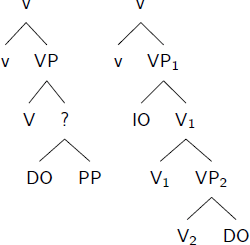
Again, Bruening’s account is not immediately applicable to Polish. According to the arguments presented in section 4.3, there is a V-DO constituent for both variants but V and DO (crucially!) do not form a constituent in the structure Bruening assigns to the to-dative. Furthermore, Bruening identifies V1 in the double object construction with an applicative head, which allows him to explain a number of well known differences in thematic interpretation between the two structures. However, this line of reasoning is not directly applicable to Polish either, as in Polish the two orders do not give rise to differences in thematic interpretation. A different hypothesis about V1 might claim that its function is to license IO’s case; such a view again lacks traction for Polish, where scope freezing, as experiment 2 shows, is strictly tied to order and independent of the case frame (see also Antonyuk 2015; 2020 for this point concerning Russian).
However, we can adopt the idea from Bruening (see also Janke & Neeleman 2012 for much relevant discussion) that the V-IO-DO structure is more complex than the V-DO-IO structure and that its asymmetry is owed to its increased complexity. We will implement this as follows. The core VP for both V-DO-IO and V-IO-DO orders is identical, as shown in (67-a–b). The indirect object moves leftward in the V-IO-DO order with concomitant head movement of the verb to H and v. Together, these structures make the constituents V, V-DO (=V’ in (67-a), V-DO-IO (=VP in (67-a), and V-IO-DO (= v’/vP in (67-b) available, as required to support the predicate clefting data. The focus projection diagnostic required IO to be superior to DO, which it is in both structures underlyingly and on the surface. The asymmetry in idiomatic interpretation arises because underlying V-DO is always a constituent to the exclusion of IO. Finally, numerically quantified adverbs placed in between the two objects strongly prefer scope exclusively over the direct object, which again follows from these structures.26
- (67)
- a.
- b.
These structures thus preserve all the hierarchical relations that we argued for in section 4.3 and which were represented schematically in (38) and (39). (67-b) elaborates (39) by adding a lower trace of IO and a functional head H between V and v. Structurally, this head roughly corresponds to Bruening’s V1 but it has no inherent semantics and is not involved in case licensing; it drives short movement of IO. We may speculate that H is motivated by the need to place stress finally in neutral contexts. The effect of the presence of H, however, is to freeze scope.
This can be formalized by making use of the observation that underlyingly IO and DO are in a mutual m-command relation but that after movement of IO to Spec,HP, HP asymmetrically m-commands DO.
We can then directly adopt Bruening’s account of scope freezing with the single modification that Shortest is defined in terms of maximal projections instead of nodes. The following definition is Bruening’s with the word ‘node’ replaced by ‘maximal projection’. It achieves the aim of making DO and IO symmetrical within the underlying VP but once IO has been moved to Spec,HP, the symmetry is broken and we can rely on the mechanisms invoked by Bruening (specifically tucking in) to enforce order preservation under multiple movements.
- (68)
- Shortest (adapted from Bruening 2001: 247, 40):
- A pair P of elements [α, β] obeys Shortest iff there is no well-formed pair P’ which can be created by substituting ɣ for either α or β, and the set of maximal projections c-commanded by one element of P’ and dominating the other is smaller than the set of maximal projections c-commanded by one element of P and dominating the other.
This set of assumptions ensures that in the V-IO-DO structure (67) DO cannot undergo quantifier raising to the edge of vP without IO undergoing quantifier raising first. Given the marked nature of quantifier scope, vacuous quantifier raising is impossible. As a result, scope between the two objects will be preserved while at the same time allowing both objects to scope above the subject.
It should be clear from this discussion, why we do not follow Łęska 2019; Gogłoza 2020 in assuming that IO forms the specifier of an applicative head: if IO and DO were base-merged in the projections of two different heads (V and Appl, respectively), our adaptation of Shortest would not distinguish between the unmoved rightward IO and the moved leftward IO. Interestingly, Gogłoza’s key claim that all datives in Polish carry the semantic feature of affectedness can still be captured under our account if we assume that dative is assigned by a silent preposition which also contributes the affectedness semantics (see Cichosz 2012; 2014 for much relevant discussion). This analysis would maybe make it less surprising why dative objects and PPs behave the same way according to our constituency diagnostics and in our experiment: dative DPs are PPs in disguise. For reasons of space we cannot develop the ramifications of this shift in perspective here.
Finally, a reviewer brings up the following example modeled on examples in Boneh & Nash 2017 and judging it to be scopally ambiguous. The first author of the current paper cannot access the inverse scope reading.
- (69)
- Messim
- Messi
- przysłał
- sent
- jednemu
- one
- chłopcu
- boy.dat
- każdą
- every
- koszulkę
- T-shirt.acc
- ze
- with
- swoimm
- self’s
- zdjęciem.
- picture
- Messi sent one boy every T-shirt with his picture
The direct object is heavy in this example. We speculate that the reviewer’s grammar (but not the first author’s) allows DO to undergo heavy shift as follows: [[V DO] IO] ⟿ [[[V tDO] IO ] DO]. This would explain the variation and tie the reading to the heaviness of DO.27
7 Conclusions and outlook
This paper has contributed to the description and analysis of multiply quantified sentences and of ditransitive VPs in Polish and beyond.
For ditransitives, we motivated a rightward ascending structure for V-DO-IO, (38), and a rightward descending one for V-IO-DO, (39), on the basis of four structural tests: predicate clefts, focus projection, idioms, and scope of numerically quantified adverbials.
Regarding scope, we found that, where word orders are comparable, English and Polish have the same distribution of quantifier scope ambiguity: SVO and V-DO-IO orders are ambiguous while V-IO-DO is unambiguous. We also found OVS orders to be ambiguous. These findings go against the widely held idea that free word order languages have a fundamentally different syntax of quantifier scope than English, whose word order is more rigid. The data strongly support the idea that there is no language-wide QR parameter tied to freedom of word order.
Given our analysis of ditransitive VPs, the fact that V-IO-DO is scopally rigid and that V-DO-IO is ambiguous argues against Antonyuk’s theory of scope freezing: Antonyuk’s theory requires IO to be lower than DO but there is no evidence for this claim. We have shown that Bruening’s 2001 theory of scope freezing, while not immediately applicable, can be adapted to Polish.
Our findings so far are consistent with the multifactorial theory of word order and scope along the lines of Bobaljik and Wurmbrand. In Experiment 1, we carefully motivated a particular word order on information structure grounds and checked whether non-linear scope was available under these conditions. Bobaljik and Wurmbrand’s account makes two further predictions that would need to be tested. Firstly, when the word order is rigid, that is when information structure manipulations cannot lead to changes in word order, Polish should behave fully like English. For example, rigid SVO order can be induced in cases in which both subject and object are marked with syncretic cases that do not distinguish between nominative and accusative and, furthermore, agent-patient relations are reversible. In such structures, non-linear scope should be available independently of information structure. Secondly, we expect that in an experiment including information structure as a factor, non-linear scope should be disfavored in experimental conditions that do not independently motivate the order. To date, this work has not been carried out.
In our exploratory study on mono-transitive sentences we corroborated that referentially independent readings of indefinites are more easily accessible than wide scope interpretations of universal quantifiers. This provides suggestive support for the (theoretically well-founded) idea that such readings do not require syntactic scope defined over c-command (see discussion around example (4)). This line of thinking suggests its own set of experiments. Referentially independent readings of indefinites should be available even in cases where universal quantifiers cannot take wide scope. Thus, the indefinite direct object in V-IO-DO orders should be able to be construed as referentially independent; this expectation has been shown to be correct (Łęska 2019: Experiment 3). Likewise, indefinites within islands should allow a referentially independent construal. With the experimental methodology developed here, it should be easy enough to verify these predictions.
Finally, we would like to return to the disagreeing claims from the literature about scope in Polish summarized in 4.2. It might be tempting to assume that the three positions we juxtaposed there reflect different grammars of scope: one type of speaker might have a Bhattacharya-Ikuta style grammar, which disallows both QR and reconstruction; the second might have a Hoji-style grammar, which allows reconstruction but not QR; and a third would allow both. We do not see strong support for this line of reasoning for the following reasons.
Among the works discussing scope in Polish, Citko 2011 comes closest to endorsing a Bhattacharya-Ikuta style characterization of the language when she claims (p. 234 fn. 38) that “[f]rozen scope is a more general fact about Polish, extending beyond double object constructions. This is not surprising; in free word order languages (such as Polish) scope generally reflects the linear ordering of the two quantifiers.”28 However, a Bhattacharya-Ikuta style analysis is about surface scope and not about linear scope. We have shown in section 4.3 using independent constituency diagnostics that linear scope in V-DO-IO structures is not surface scope; in this particular case, linear scope involves scope inversion. There is then no support in the theoretical literature for a true Bhattacharya-Ikuta style analysis of scope in Polish. This corresponds well with our experimental findings. In particular, in our initial exploratory study – conducted under well-controlled conditions – no participant always disallowed non-surface scope. While such participants did turn up in the online replication of the exploratory study and in experiment 1, we believe that this is a task effect and owed to the much greater noise in online experimentation.
This leaves us with the possibility that some speakers of Polish might have a Hoji-style grammar with reconstruction but without (scope-shifiting) QR while other speakers do have scope-shifting QR. We cannot rule out this possibility categorically. After all, in the laboratory-based run of the exploratory study there were 3 out of 17 participants who never allowed a universally quantified object to take scope over an indefinite subject in any of the SVO trials. Does this prove that there are speakers who do not have scope-shfiting QR? Probably not. There were only four items per condition, so statistical power is low. A different experiment with many more items per speaker would be needed to establish the point. Clearly, if Hoji-style speakers exist, there can’t be very many: if there were a large number of them, we would expect a clear bi-modal distribution in the S… VO monoclause condition of Experiment 1; however, plot (65) shows no sign of bi-modality pointing to at most a small number of such speakers. Indeed, there is some reason to be skeptical that such speakers exist at all; in the pretest for the ditransitive items (fn. 2 of Appendix II), all participants accessed the linear, distributive reading for V-DO∀-IO∃ at least some of the time. Since this reading requires covert scope shift, it is reasonable to assume that all speakers in principle allow covert scope shift and none have a strictly Hoji-style grammar. A definitive conclusion would need to rely on further experimentation and would require much more statistical power to make solid inferences about speakers’ (possibly distinct) grammars.
If we assume that there are no Polish speakers with a Hoji-style grammar, we are left with the puzzle of why Karnowski 2001 reports that SVO sentences are unambiguous. Unfortunately, we do not know what contexts Karnowski used, so we can only speculate. Recall that Bobaljik & Wurmbrand’s ScoT predicts scope transparency in free word order languages unless there is a reason independent of scope that would motivate the particular word order. In Experiment 1 this independent reason was the given-before-new preference of Polish. We suspect that Karnowski’s judgments were elicited without setting up a context that would independently favor the word order of the examples. The predictable result are his reported judgments of scope rigidity.
Data availability
The data are available from the corresponding author upon reasonable request.
Notes
- ‘Overtly crossed’ and ‘not overtly crossed’ would be more precise but is too cumbersome. [^]
- Examples whose surface and inverse scope interpretations do not entail each other (see Reinhart 2006 chapter 2 for a well written exposition) are complex and hard to judge. The experiments therefore rely on simpler cases like (3) and (4). [^]
- Under the rightward ascending structure in (7) surface scope and linear scope diverge. We use the following terminology: surface scope always obeys the surface c-command irrespective of linear order, linear scope obeys the linear surface order irrespective of c-command, inverse scope reverses the surface c-command relations, and non-linear scope is right-to-left scope. [^]
- The question of whether verb movement targets a functional head (e.g., v0) or is reprojecting is orthogonal to our concerns. The diagnostics in section 4.3 do not bear on it. In section 6, the skeleton of (11) will be embellished as (67) by adding functional heads and a step of movement for IO. Crucially, none of these embellishments alter the overall geometry of the ditransitive VP. [^]
- It is often assumed (Heim & Kratzer 1998; Hackl 2013) that object quantifiers must undergo QR for type reasons, though see Keenan 2016 for a system avoiding this. Indeed, following Reinhart 2006 we will assume that object quantifiers are by default interpreted in situ with surface scope and that QR is marked and implements scope shift. This choice is not crucial to our analysis. [^]
- In systems in which QR is necessary to interpret quantifiers in object position, the modifier ‘scope extending’ becomes crucial. [^]
- Miyagawa 2010 and Yatsushiro 1996 contain important data that undermine Hoji’s analysis. This has not reduced the theoretical influence of the proposal, however. [^]
- (18) is a revision of Antonyuk 2015: 75 #40 which made all crossed configurations scopally rigid:
- (i)
- Scope Freezing Generalization: Scope freezing results when one QP raises over another to a c-commanding position as a result of a single instance of movement.
To account for the scope ambiguity of OVS structures in Russian, (i) required a (poorly motivated) smuggling derivation (see Antonyuk 2015: section 3.5.3). (i) also predicts OSV structures to be scopally rigid. This prediction is not borne out in Russian (Antonyuk, p.c., contra Antonyuk 2015: 65 ex. 26b). Since Polish OSV structures like (ii) clearly allow inverse scope, we discuss here Antonyuk’s later restriction of the scope freezing generalization to VP-internal permutations. [^]- (ii)
- Jedną
- one
- książkę
- book.acc
- każdy
- everyone.nom
- napisał.
- wrote
- Everyone wrote one book.
- Our own analysis of this class of verbs in Polish is motivated in 4.3 and differs sharply from Antonyuk’s: we represent V-DO-IO as (7) and V-IO-DO as (11). We suspect that Russian class I verbs can be analyzed similarly (see 6 for brief comments). [^]
- Here and throughout we use A > B to indicate that A scopes over B, A ≺ B to indicate that A precedes B, and A » B to indicate that A c-commands B. [^]
- While it is reasonable to assume that Bobaljik and Wurmbrand intend ‘»’ to indicate c-command at LF, it is difficult to know whether they mean c-command at PF or precedence. [^]
- Bobaljik & Wurmbrand’s notion of focus corresponds roughly to new material. Their notion of topic is somewhat narrower than the notion of given employed here, which is akin to the ‘ground’ in Vallduví & Engdahl 1996. [^]
- The two translations of the second instance of the word Indianin–’Native American’ are intended to signal that a given noun phrase need not be specific or definite. [^]
- The example is not directly comparable to Szczegielniak’s and Karnowski’s examples, because at every meeting is, of course, not a direct object but a locative PP. In English, examples like Witkoś’s allow inverse scope with particular ease:
[^]
- (i)
- A guard is standing in front of every building.
- An anonymous reviewer notes that they do not accept (37) with co in combination with VP ellipsis. [^]
- Note that the discussion here is not intended to cover all ditransitive verbs or ditransitive verb classes in Polish (see Łęska 2019 and Boneh & Nash 2017; Marvin & Stegovec 2012; Kučerova 2007; Gračanin-Yuksek 2007; Antonyuk 2020 for Slavic more generally). For example acc-ins verbs do not pattern with the verbs discussed here. Crucially, all verbs in experiment 2 behave uniformly with respect to the four tests discussed in this subsection. In that specific sense they are members of a uniform class and support an analysis in terms of the two structures in (38) and (39), which claim that DO always forms an underlying constituent with the verb to the exclusion of IO and that V-DO-IO structures are rightward ascending while V-IO-DO structures are rightward descending. This overall geometry can, of course, be embellished with various functional heads which might serve to further subclassify these ditransitives. However, all such analyses must respect the conclusions about the uniform coarse-grained geometry argued for here. This uniformity should maybe not be too surprising: all verbs we use fall in Antonyuk’s (2015) class I, and those that take two DPs all come from Dvořak’s (2010) dat>acc class, and Boneh & Nash’s (2017) Group I, the group of canonical ditransitives. Using different diagnostics, the above authors demonstrate within-class syntactic uniformity for these verbs. We have to leave more comprehensive discussion for another occasion. [^]
- Citko (2011: 122 ex. 46) gives weak crossover effects as an argument in favor of the assumption that IO asymmetrically c-commands DO in Polish. We do not repeat her argument here; the data are confounded by the use of different wh-words in IO (któremu–’which.dat’) and in DO (czyj–’whose’). The asymmetry disappears once this factor is controlled. [^]
- Gogłoza 2020 suggests that the fact that V-DO can nominalize without including IO but that V-IO cannot nominalize without including DO suggests that V and DO form a constituent to the exclusion of IO. An anonymous reviewer points out that without a strong theory linking constituency and position, we cannot interpret the asymmetry. The reviewer also observes that the asymmetry is already present in the verbal domain.
- The data represent the first author’s intuitions. Recent experimental work supports this characterization at best weakly (Šimik & Wierzba 2017), but the experiment fails to control animacy, givenness, specificity, and presuppositionality of both objects. [^]
- The asymmetry between stress on a direct and indirect object becomes even sharper when one of the objects is moved: stress on the direct object allows focus to project and encompass V, (i), while stress on the indirect object induces narrow focus on the indirect object only, (ii).
- (i)
- A:
- Co
- What.acc
- Marysia
- Mary.nom
- zrobiła
- did
- tygrysowi?
- tiger.dat
- What did Mary do to the tiger?
- B:
- Marysia
- Mary.nom
- tygrysowi
- tiger.dat
- odebrała
- took away
- OWCĘ.
- sheep.acc
- Mary took the sheep away from the tiger.
- (ii)
- A:
- Co
- What.acc
- Marysia
- Mary.nom
- zrobiła
- did
- owcy?
- sheep.dat
- What did Mary do to the sheep?
Again, this is just as we would expect. [^]- B:
- #Marysia
- Mary.nom
- owcę
- sheep.acc
- odebrała
- take away
- TYGRYSOWI.
- tiger.dat
- Mary took the sheep away from the tiger.
- Grabska (2013) shows furthermore that when the DAT-ACC distinction is morphologically neutralised, the order DAT before ACC is clearly preferred in non-contrastive contexts and takes this to indicate that the neutral order is indirect object before direct object (see Kučerova 2007 for a similar conclusion regarding Czech). [^]
- Dyakonova (2007) observes the same asymmetry in Russian and interprets it as Witkoś & Dziemianko 2006 and we do. Titov (2017) criticises this argument from the perspective of a theory according to which the merge order is determined not only by the grammatical function of an argument, but also by its animacy and referentiality: idiomatic objects are crucially not animate and not referential. While we cannot answer Titov’s objection directly because animacy and referentiality cannot be controlled with idioms, we should point out that the argument from idioms dovetails with the conclusions based on nonidiomatic examples in the discussion above. Those examples carefully controlled animacy and referentiality and the conclusion was the same: V-DO is a constituent to the exclusion of IO but V-IO is never a constituent to the exclusion of DO. [^]
- The literature on Russian points out three asymmetries between direct and indirect object and interprets them as support for structure (8): reciprocal binding, pronominal binding, and instrumental secondary depictive predicates. The Russian facts are as follows: (i) IO can bind a DO reciprocal only when IO precedes DO but DO can bind an IO reciprocal no matter what order obtains (Bailyn 1995 but see Dyakonova 2007; Boneh & Nash 2017 for important caveats). (ii) An A’-moved direct object can bind a pronominal possessor in the indirect object, but not the other way around (Bailyn 2010). (iii) DO can but IO cannot control an instrumental secondary predicate.
Asymmetries (i) and (ii) do not exist in Polish. Reciprocal binding between IO and DO is strictly linear (Witkoś & Dziubała-Szrejbrowska & Łęska 2018), which can be implemented in terms of precede and m-command given our structures. Any adequate formulation of binding theory for Polish (i.e., obligatory (non-)coreference effects) needs to take into account hierarchical structure, linear order, and information structure (see Witkoś 2021 for discussion and references). For reasons of space, we cannot explore the issue here but simply illustrate the obligatory non-coreference effect akin to condition C in the absence of (overt) c-command between the pronoun and the R-expression:
The second asymmetry also fails to exist in Polish. A’-moved objects - both direct and indirect - in ditransitive structures do not give rise to weak crossover effects when binding a pronoun in the other object. This is consistent with our view of the structure of ditransitives as long as it is recognized that weak crossover has a linear component. This conclusion is independently supported. (ii) should give rise to a weak-crossover violation under a strictly hierarchical view but not under one invoking both hierarchy and order:
- (i)
- *Ta
- this
- książka
- book
- o
- about
- nim1
- him
- zirytowała
- irritated
- Janka1
- John.
- This book about him1 irritated John1 Witkoś 2021: 20 89a
Finally, Polish behaves similarly to Russian when it comes to (iii) – though the relevant Polish secondary predicates are adverbial rather than instrumental in form. Bailyn suggests that indirect objects cannot control the secondary predicates in question because they are merged too low. However, in Polish the failure of indirect objects to control them cannot be attributed to their low attachment site. This is because no datives control adverbial secondary predicates no matter how high their first merge position may be. As shown in Cichosz 2012, this is true even of affectedness datives, which are first-merged very high (above the subject). Yet, they cannot control the secondary predicates under discussion. Cichosz suggests that datives fail to control them because of an inaudible case-shell, which assimilates them to PPs which also fail to control them independently of their first-merge position. [^]- (ii)
- Which mank did you [stop visiting tk ] [because you couldn’t stand hisk mother]?
- Because data collection was moved online for experiment 1, we replicated this study online (with 62 participants, 55 of which passed our filters). Data was collected in line with GDPR and participants gave informed consent. While the results of the internet based data collection are considerably more noisy than in the original study, they are broadly similar to the laboratory version. Notice that numerically the results are considerably lower especially in the SVO ∃ ≺ ∀ condition:
Fitting a linear mixed effects model produced highly significant main effects of word order, quantifier order, and a significant interaction. [^]
- word order
- SVO
- SVO
- OVS
- OVS
- quantifier order
- ∃ ≺ ∀
- ∀ ≺ ∃
- ∃ ≺ ∀
- ∀ ≺ ∃
- mean
- 0.33
- 0.85
- 0.58
- 0.81
- sd
- 0.47
- 0.35
- 0.49
- 0.38
- We would like to thank an anonymous reviewer for insisting on the necessity of this experiment. [^]
- The extremely high acceptance rate of referentially independent indefinites in the exploratory study and the main effect of quantifier order in that study suggest that the theoretically derived hypothesis, according to which in contrast to distributive interpretations of universal quantifiers such readings do not require QR, is correct. To corroborate this hypothesis, an experiment crossing the factors structure (with the levels monoclause and island) and quantifier (with the levels ∃ ≺ ∀ and ∀ ≺ ∃) would need to be conducted. The crucial effect would be an interaction, such that the referentially independent reading of the indefinite is less strongly affected by the island structure than the inverse scope interpretation of the universal. As this is not a paper on indefinites, we do not pursue the issue here. [^]
- There is some scope to accommodate variation here. As mentioned above, a reviewer of this paper reports no asymmetry between predicate clefts involving V-IO and those involving V-DO: for the reviewer both are equally marginal and highly dependent on supporting context. This can be accounted for by assuming that this reviewer’s grammar prohibits predicate clefting of the intermediate V’ projection. This would leave the verb to front alone or together with both of its objects. The marginal but context sensitive availability of both V-DO and V-IO predicate clefts then requires an account in terms of further context sensitive movement plus remnant movement of VP or vP. Such additional movements might be independently justified. We reported above in section 4.3 that independently of the order of the objects, numerically quantified adverbs placed between the objects by default take scope exclusively over the direct object. We also noted that (53-b) additionally allows left-to-right scope. This reading requires the numerically quantified adverb to be adjoined above VP. If we assume right-adjunction of the adverb, we additionally need to invokve rightward movement of IO with LF reconstruction. If we assume left-adjunction of the adverb, we additionally need to invoke movement of the DO. Either way, these additional movements have to be marked, since the left-to-right scope order is not the default reading and this markedness connects well with the markedness observed for the reviewer’s predicate clefting judgments: both require additional and – crucially – marked movement operations. [^]
- Variation in the availability of heavy shift might also explain why some Russian speakers do and some do not allow reverse reciprocal binding in V-IO-DO structures (see Bailyn 1995; 2010; Boneh & Nash 2017; Dyakonova 2007; Testelets 2001 and footnote 22). The same variation in the acceptability of heavy shift for Russian speakers could also be involved in the variability of scope judgments for V-IO-DO structures in Russian; these are reported to allow inverse scope for some verbs in Boneh & Nash 2017 that Antonyuk 2015 claims to be scopally rigid with that order. Heaviness could play a role either instead of or in addition to the factor of givenness mentioned above. [^]
- To be fair to Citko, this was probably never meant as a serious characterization of scope in Polish. Her main point in the passage under discussion is the claim, which we do not contest, that V-IO-DO is unambiguous and only allows linear scope. [^]
Supplementary materials
The supplementary files for this article can be found here: DOI: https://doi.org/10.16995/glossa.8170.S1
The supplementary file contains the following materials:
Appendix I: Experimental and filler sentences for Experiment 1.
Appendix II: a report on Experiment 2. As mentioned above, Experiment 2 replicates, with a somewhat different method, the main result of the experiments in Łęska 2019: Polish V-IO-DO orders are scopally rigid while V-DO-IO orders are ambiguous. In addition to a replication of Lęska’s results, Experiment 2 allows us to broaden the generalization about the availability of scope ambiguities from IOs that are realized as dative DPs to IOs that are realized as PPs.
Appendix III: experimental and filler sentences for Experiment 2.
Ethics and consent
The research reported here was approved by the research ethics committee of the linguistics department at UCL (LING-2015-03-23).
Acknowledgements
We would like to thank the audiences at FASL26 and SlavicLingColl and the anonymous glossa reviewers for their insightful and helpful comments on earlier versions of this material.
Competing interests
The authors have no competing interests to declare.
References
Anderson, Catherine. 2004. The structure and real-time comprehension of quantifier scope ambiguity. Evanston, Illinois: Northwestern University dissertation.
Antonyuk, Svitlana. 2015. Quantifier scope and scope freezing in Russian. Stony Brook: Stony Brook University dissertation.
Antonyuk, Svitlana. 2019. Quantifier scope in Russian. Glossa 4(1). 1–54. DOI: http://doi.org/10.5334/gjgl.562
Antonyuk, Svitlana. 2020. The puzzle of Russian ditransitives. In Pineda, Anna & Mateu, Jaume (eds.), Dative constructions in Romance and beyond, 43–74. Berlin: Language Science Press.
Bailyn, John Frederick. 1995. A configurational approach to russian “free” word order. Cornell University dissertation.
Bailyn, John Frederick. 2010. What’s inside vp? new (and old) evidence from russian. Formal Approaches to Slavic Linguistics 18. 21–37. DOI: http://doi.org/10.1353/jsl.2010.0000
Barss, Andrew. 1986. Chains and anaphoric dependence: on reconstruction and its implications. MIT dissertation.
Bates, Douglas & Machler, Martin & Bolker, Ben & Walker, Steve. 2015. Fitting linear mixedeffects models using lme4. Journal of Statistical Software 67(1). 1–48. DOI: http://doi.org/10.18637/jss.v067.i01
Bhattacharya, Nindini. 2014. Semantics of Quantification in Bangla. Ms. University of Dheli.
Bobaljik, Jonathan David & Wurmbrand, Susi. 2012. Word order and scope: transparent interfaces and the ¾. signature. Linguistic Inquiry 43(2). 371–421. DOI: http://doi.org/10.1162/LING_a_00094
Bondaruk, Anna. 2012. Copy deletion in polish predicate clefting. Sound, structure and sense. Studies in Memory of Edmund Gussmann.
Boneh, Nora & Nash, Lea. 2017. The syntax and semantics of dative DPs in Russian ditransitives. Natural Language and Linguistic Theory 35. 899–953. DOI: http://doi.org/10.1007/s11049-017-9360-5
Bruening, Benjamin. 2001. QR obeys superiority: frozen scope and ACD. Linguistic Inquiry 32(2). 233–273. DOI: http://doi.org/10.1162/00243890152001762
Cichosz, Natalia. 2012. High datives in Polish. Upgrade paper, UCL.
Cichosz, Natalia. 2014. Polish experiencer and affectedness datives as adjuncts. Proceedings of ConSOLE 22. 39–57.
Cinque, Guglielmo. 1993. A null theory of phrase and compound stress. Linguistic Inquiry 24(2). 239–298.
Citko, Barbara. 2011. Symmetry in syntax: merge, move, and labels. Cambridge University Press. DOI: http://doi.org/10.1017/CBO9780511794278
Gogłoza, Aleksandra. 2020. Polish datives - an applicative analysis. Berlin: Humboldt Universitat zu Berlin dissertation.
Dvořak, Věra. 2010. On the syntax of ditransitive verbs in Czech. In Browne, E. Wayles & Cooper, Adam & Fisher, Alison & Kesici, Esra & Predolac, Nikola & Zec, Draga (eds.), Proceedings of FASL 18: the second Cornell meeting 2009, 161–177. Michgan Slavic Publications.
Dyakonova, Marina. 2007. Russian double object constructions. ACLC Working Papers 2. 3–30.
Fox, Danny. 2000. Economy and semantic representation. Cambridge, MA: MIT Press & MITWPL.
Frey, Werner. 1993. Syntaktische Bedingungen fur die semantische Interpretation (Studia Grammatica 35). Berlin: Akademie Verlag.
Grabska, Dagmara. 2013. Scope mechanisms in doubly quantified constructions in Polish. London: UCL MA thesis.
Grabska, Dagmara. 2017. Experimental investigation of scope in doubly-quantified structures in Polish. Ms. UCL.
Gračanin-Yuksek, Martina. 2007. Double object construction in Croatian: arguments against appl0. In Compton, Richard & Goledzinowska, Magdalena & Savchenko, Ulyana (eds.), Proceedings of fasl 15: the toronto meeting 2006, 94–112. Michigan Slavic Publications.
Hackl, Martin. 2013. The syntax–semantics interface. Lingua 130. SI: Syntax and cognition: core ideas and results in syntax, 66–87. https://www.sciencedirect.com/science/article/pii/S0024384113000314. DOI: http://doi.org/10.1016/j.lingua.2013.01.010
Haider, Hubert. 1993. Deutsche Syntax, generativ: Vorstudien zur Theorie einer projektiven Grammatik. Tubingen: Gunter Narr Verlag.
Haider, Hubert. 2005. How to turn German into Icelandic - and derive the OV-VO contrasts. The Journal of Comparative Germanic Linguistics 8. 1–56. DOI: http://doi.org/10.1007/s10828-004-0293-0
Haider, Hubert. 2006. Mittelfeld phenomena (Scrambling in Germanic). In Everaert, Martin & van Riemsdijk, Henk (eds.), The Blackwell companion to syntax, vol. 3, chap. 43, 204–274. Malden, MA: Blackwell Publishers. DOI: http://doi.org/10.1002/9780470996591.ch43
Halle, Morris & Vergnaud, Jean-Roger. 1987. Stress and the cycle. Linguistic Inquiry 18(1). 45–84.
Harada, Naomi & Larson, Richard K. 2009. Datives in Japanese. Proceedings of the 5th Workshop on Altaic Formal Linguistics. MIT Working Papers in Linguistics Cambridge, MA. 54(5). 3–17.
Heim, Irene & Kratzer, Angelika. 1998. Semantics in generative grammar. Malden, MA.: Blackwell Publishers.
Hoji, Hajime. 1985. Logical form constraints and configurational structures in Japanese. University of Washington dissertation.
Hoji, Hajime. 1995. Demonstrative binding and Principle B. In Beckman, Jill (ed.), Proceedings of the north east linguistic society 25, 255–272. University of Pennsylvania: Graduate Linguistic Student Association.
Hornstein, Norbert. 1995. Logical Form: from GB to Minimalism. Cambridge, USA: Blackwell.
Ikuta, Toshikazu. 2015. Interactions between quantifier scope and topic/focus. Florida Linguistics Papers 2.
Ionin, Tania R. & Luchkina, Tatiana. 2018. Focus on Russian scope: an experimental investigation of the relationship between quantifier scope, prosody, and information structure. Linguistic Inquiry 49(4). 741–779. DOI: http://doi.org/10.1162/ling_a_00288
Janke, Victoria & Neeleman, Ad. 2012. Ascending and descending VPs in English. Linguistic Inquiry 43(2). 151–190. DOI: http://doi.org/10.1162/LING_a_00082
Karnowski, Pawel. 2001. Zum relativen Quantorenskopus im Polnischen. In Zybatow, Gerhild & Junghanns, Uwe & Mehlhorn, Grit & Szucsich, Luka (eds.), Current issues in formal Slavic linguistics, vol. 5 (Linguistik International), 426–435. Peter Lang.
Keenan, Edward L. 2016. In situ interpretation without type mismatches. Journal of Semantics 33. 87–106.
Kučerova, Ivona. 2007. The syntax of givenness. Cambridge, MA: MIT dissertation.
Larson, Richard K. 1988. On the double object construction. Linguistic Inquiry 19. 335–391.
Lechner, Winfried. 1998. Two kinds of reconstruction. Studia Linguistica 52(3). 276–310. DOI: http://doi.org/10.1111/1467-9582.00037
Łęska, Paulina. 2019. Quantifier scope as a diagnostic for the position of arguments of ditransitive verbs. Poznań: University of Poznań dissertation. DOI: http://doi.org/10.3726/b16515
Marvin, Tatjana & Stegovec, Adrian. 2012. On the syntax of ditransitive sentences in Slovenian. Acta Linguistica Hungarica 59(1–2). 177–203. DOI: http://doi.org/10.1556/ALing.59.2012.1-2.8
Miyagawa, Shigeru. 2010. Why agree? why move?: unifying agreement-based and discourse configurational languages. Vol. 54 (Linguistic Inquiry Monograph). Cambridge, MA: MIT Press. DOI: http://doi.org/10.7551/mitpress/8116.001.0001
Miyagawa, Shigeru & Tsujioka, Takae. 2004. Argument structure and ditransitive verbs in Japanese. Journal of East Asian Linguistics 13. 1–38. DOI: http://doi.org/10.1023/B:JEAL.0000007345.64336.84
Neeleman, Ad & Weerman, Fred. 1999. Flexible syntax. Kluwer Academic Publishers. DOI: http://doi.org/10.1007/978-94-011-4289-2
Pafel, Jurgen. 2005. Quantifier Scope in German. John Benjamins. DOI: http://doi.org/10.1075/la.84
R Core Team. 2019. R: A Language and Environment for Statistical Computing. R Foundation for Statistical Computing. Vienna, Austria. https://www.R-project.org/.
Reinhart, Tanya. 2006. Interface strategies. MIT Press. DOI: http://doi.org/10.7551/mitpress/3846.001.0001
Schwarzschild, Roger. 2002. Singleton indefinites. Journal of Semantics 19(3). 289–314. DOI: http://doi.org/10.1093/jos/19.3.289
Scontras, Gregory & Polinsky, Maria & Tsai, C.-Y. Edwin. 2017. Cross-linguistic scope ambiguity: when two systems meet. Glossa 1. 1–28. https://www.glossa-journal.org/articles/abstract/10.5334/gjgl.198/. DOI: http://doi.org/10.5334/gjgl.198
Šimík, Radek & Wierzba, Marta. 2017. Expression of information structure in West Slavic: modeling the impact of prosodic and word-order factors. Language 93(3). 671–709. DOI: http://doi.org/10.1353/lan.2017.0040
Szabolcsi, Anna (ed.). 1997. Ways of scope taking. Dordrecht; Boston; London: Kluwer Academic Publishers. xxi, 466. DOI: http://doi.org/10.1007/978-94-011-5814-5
Szczegielniak, Adam. 2005. Relativization that you did… MIT Occasional Papers in Linguistics 24.
Tanaka, Misako. 2020. Similarities and differences between quantifier raising and Wh movement out of adjuncts. Syntax 23(2). 152–184. DOI: http://doi.org/10.1111/synt.12189
Testelets, Yakov. 2001. Vvedenie v obščij sintaksis. Moscow: RGGU.
Titov, Elena. 2017. The canonical order of Russian objects. Linguistic Inquiry 48(3). 427–457. DOI: http://doi.org/10.1162/ling_a_00249
Vallduví, Enric & Engdahl, Elisabet. 1996. The linguistic realization of information packaging. Linguistics 34. 459–519. DOI: http://doi.org/10.1515/ling.1996.34.3.459
Wiland, Bartosz. 2009. Aspects of order preservation in Polish and English. Adam Mickiewicz University in Poznań dissertation.
Winter, Yoad. 2001. Flexibility principles in Boolean semantics. Cambridge, MA: MIT Press. DOI: http://doi.org/10.7551/mitpress/3034.001.0001
Witkoś, Jacek. 2000. On the preference principle and some aspects of reconstruction in a’ and a chains in polish. Poznań Studies in Contemporary Linguistics 36.
Witkoś, Jacek. 2021. Posessive pronouns, condition c and anti-cataphora effects. Lingua 259. DOI: http://doi.org/10.1016/j.lingua.2021.103109
Witkoś, Jacek & Dziemianko, Anna. 2006. On the syntax of idioms and the idiomatic constituency axiom. Wydawnictwo Naukowe UAM.
Witkoś, Jacek & Dziubała-Szrejbrowska, Dominika & Łęska, Paulina. 2018. Binding as Agree and index raising: the case of Polish accusative object experiencers. Poznań studies in contemporary linguistics 54(4). 469–507. DOI: http://doi.org/10.1515/psicl-2018-0020
Wurmbrand, Susi. 2018. The cost of raising quantifiers. Glossa: a journal of general linguistics 3(1). 1–40. https://www.glossa-journal.org/articles/10.5334/gjgl.329/. DOI: http://doi.org/10.5334/gjgl.329
Yatsushiro, Kazuko. 1996. Case, scope, and feature movement. In Oishi, Masayuki & Koizumi, Masatoshi & Sauerland, Uli (eds.), Proceedings of formal approaches to japanese linguistics 2, 319–355. MITWPL.
Zubizarreta, María Luisa. 1998. Prosody, focus, and word order (Linguistic Inquiry Monograph 33). Cambridge, MA: MIT Press.
Zubizarreta, María Luisa & Vergnaud, Jean-Roger. 2006. Phrasal stress and syntax. In Everaert, Martin & van Riemsdijk, Henk (eds.), The Blackwell companion to syntax, vol. I, 522–568. Malden, MA: Blackwell Publishers. DOI: http://doi.org/10.1002/9780470996591.ch49

